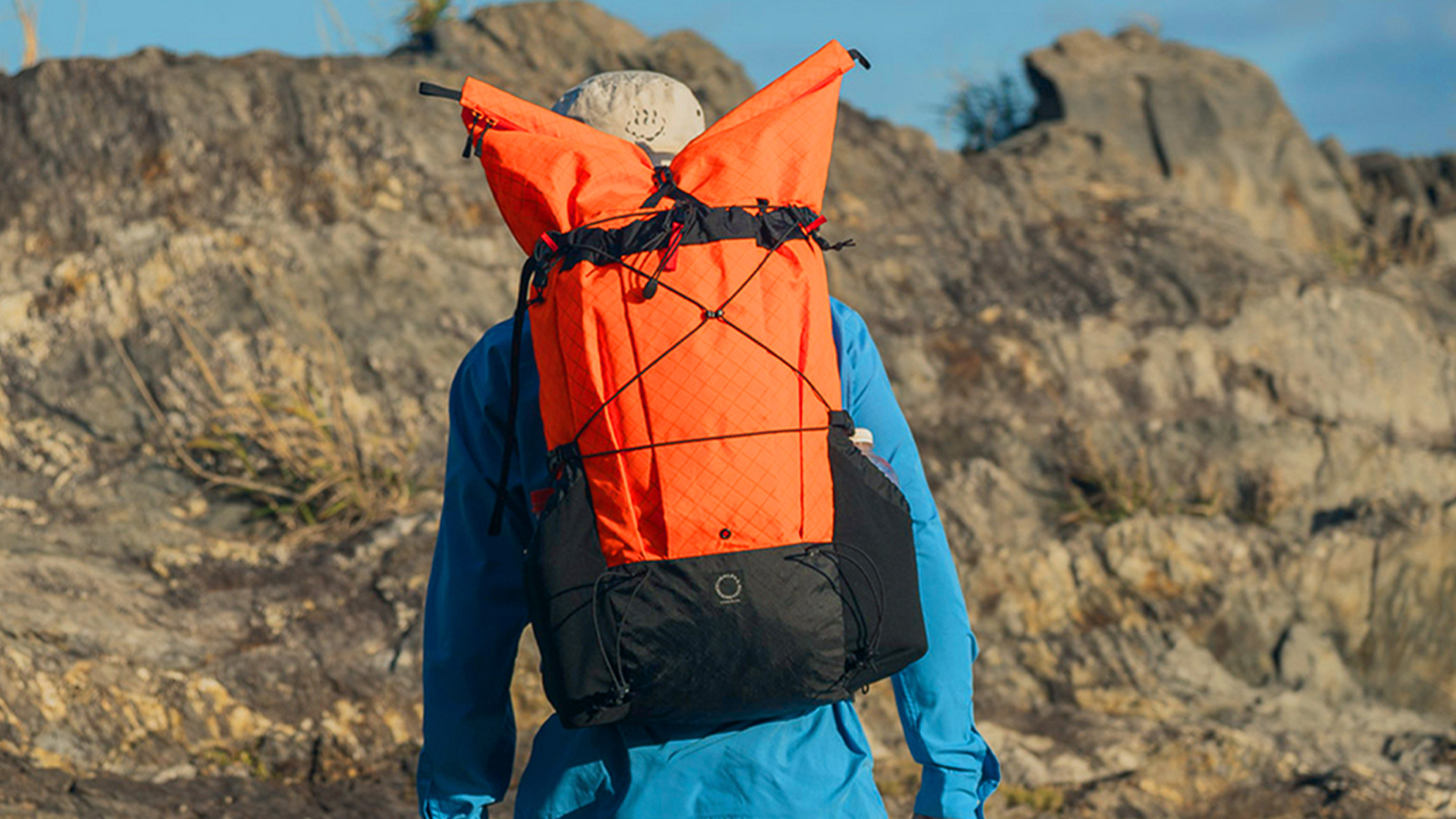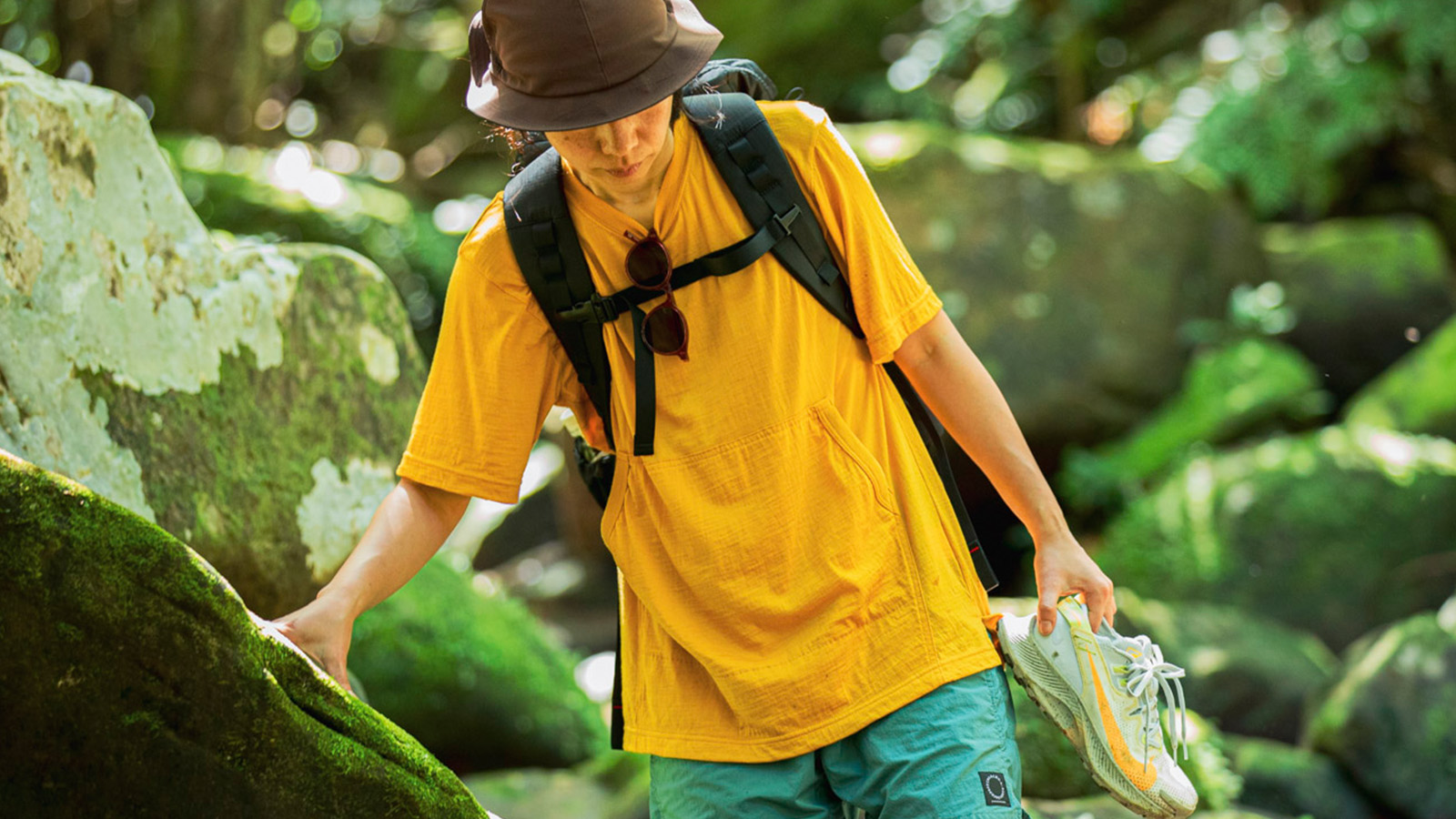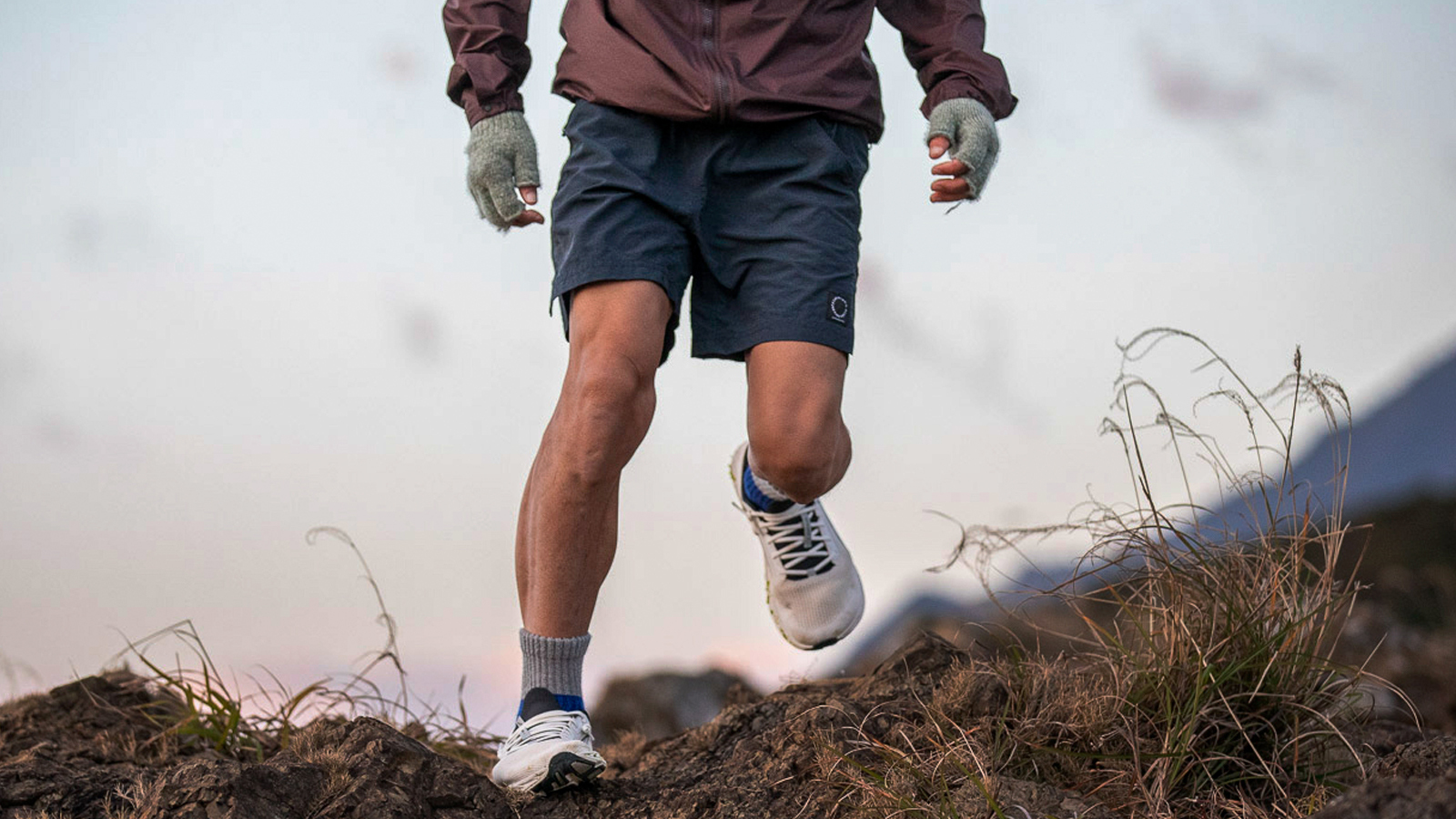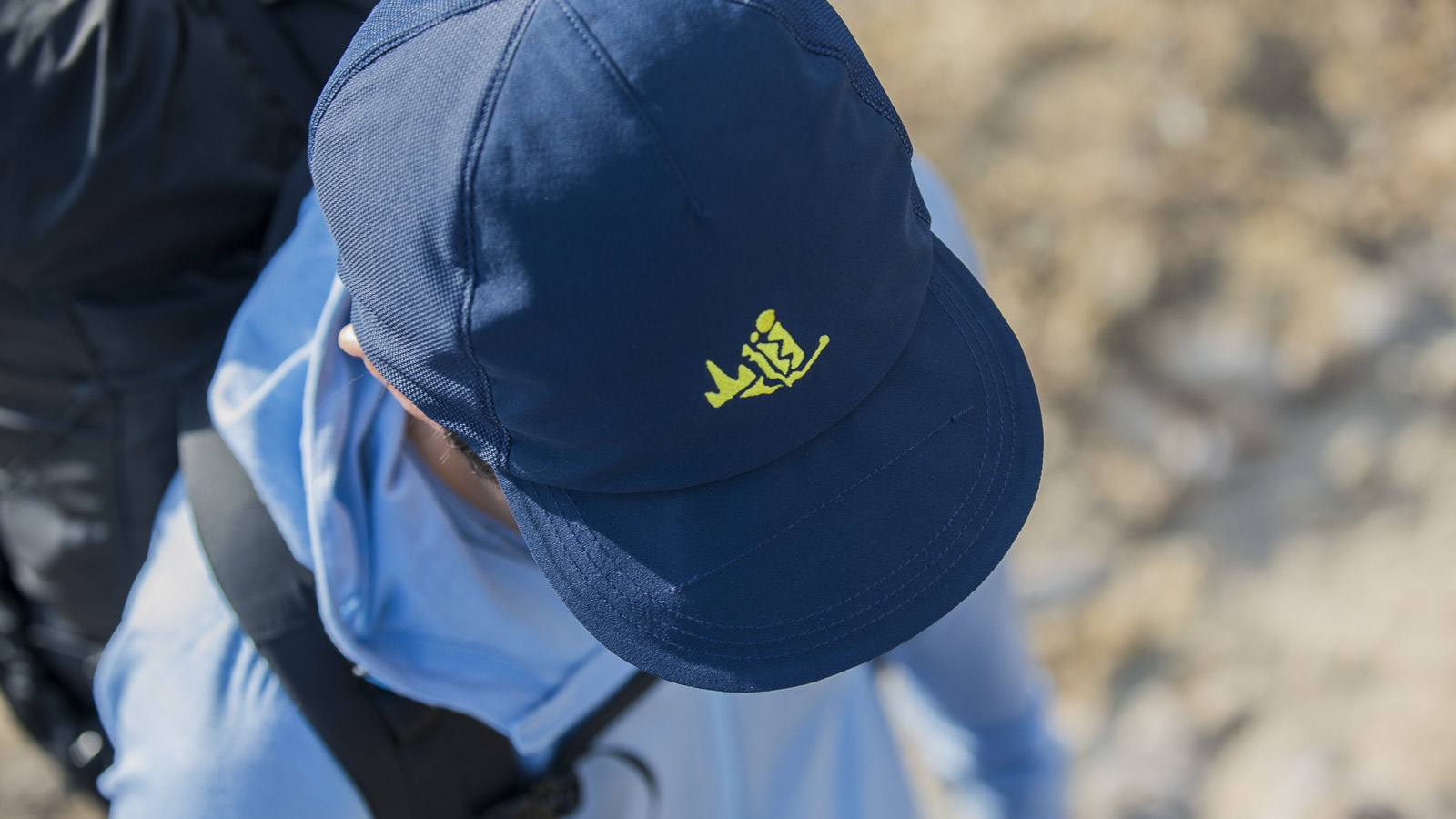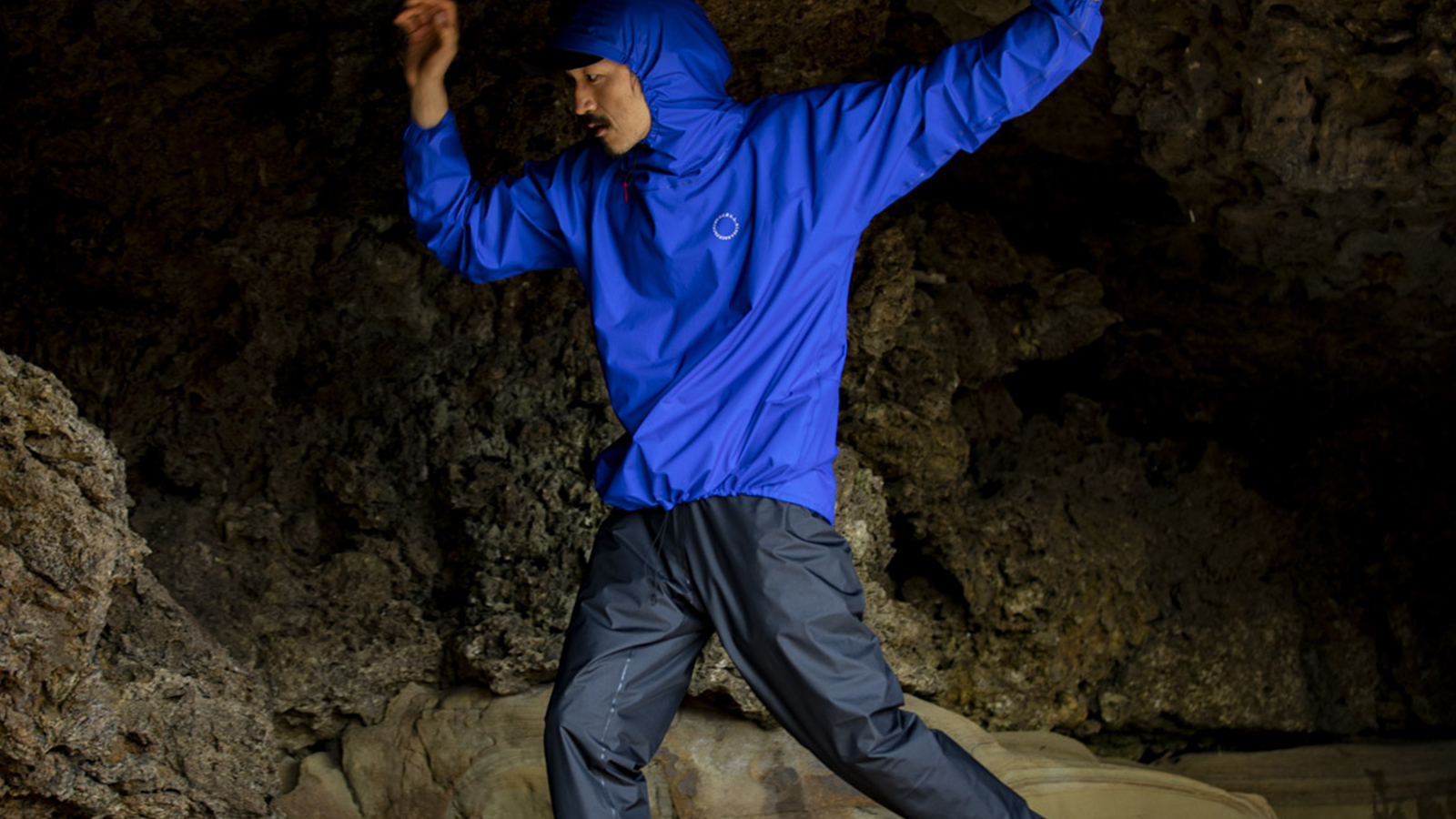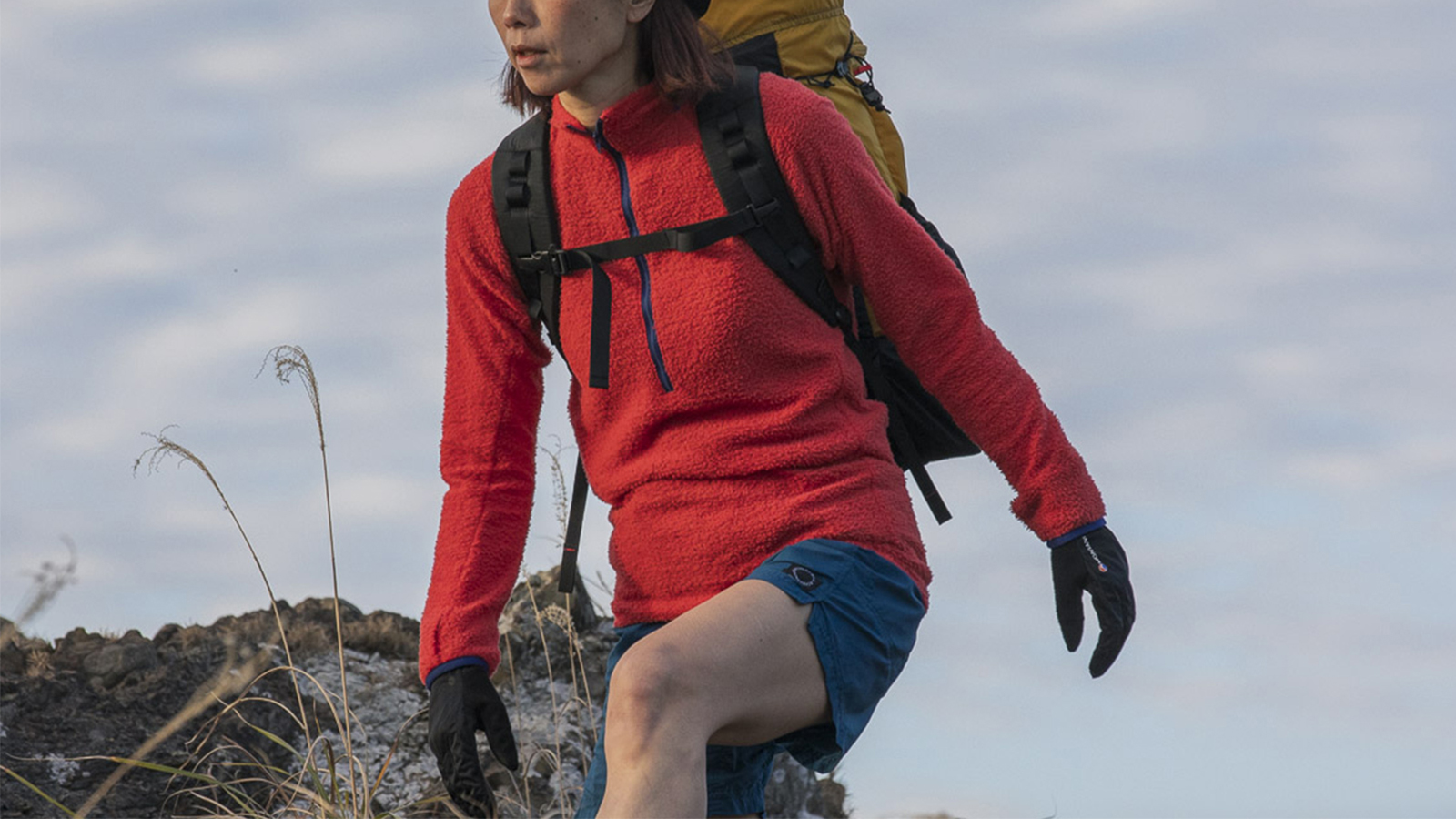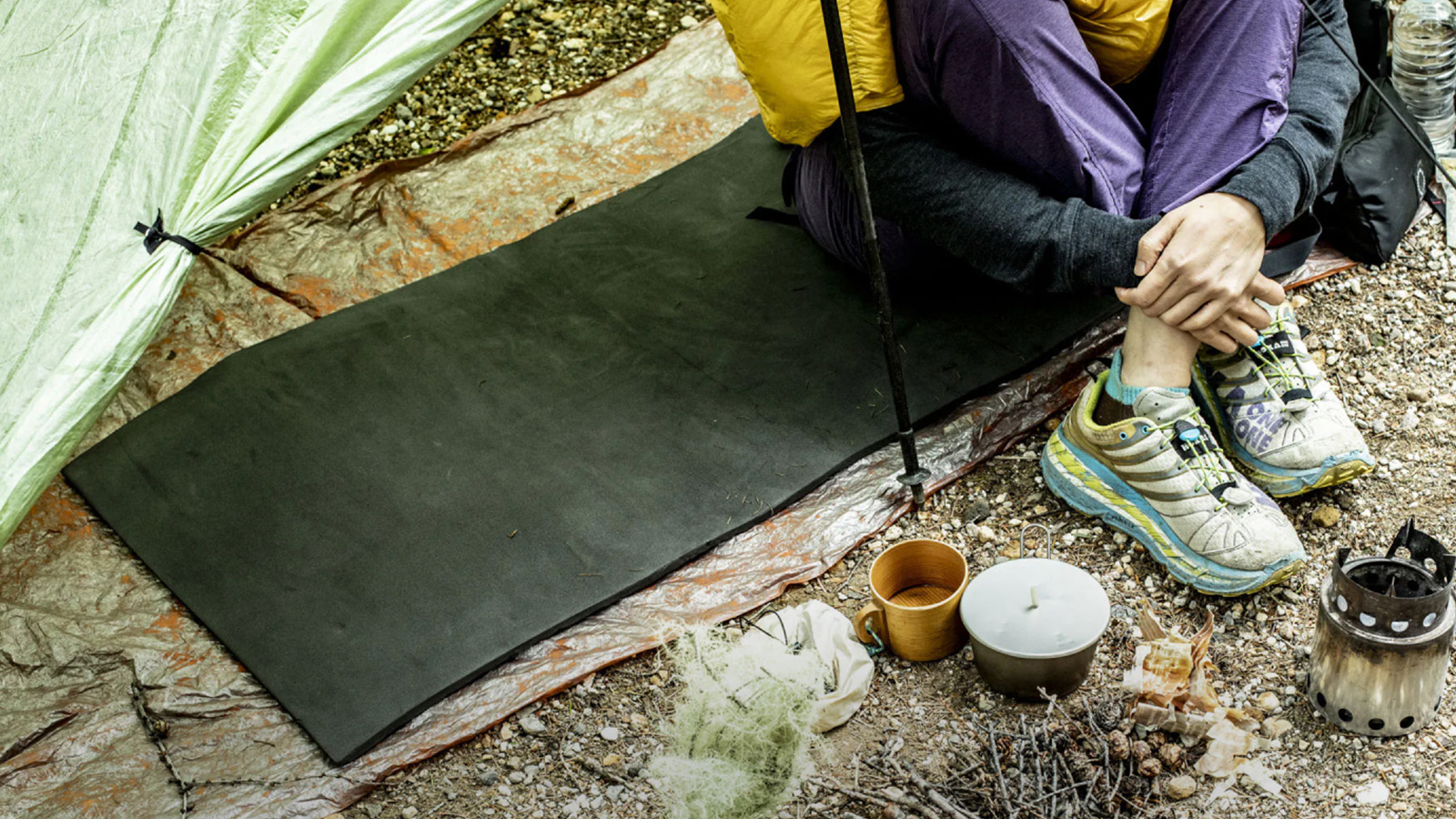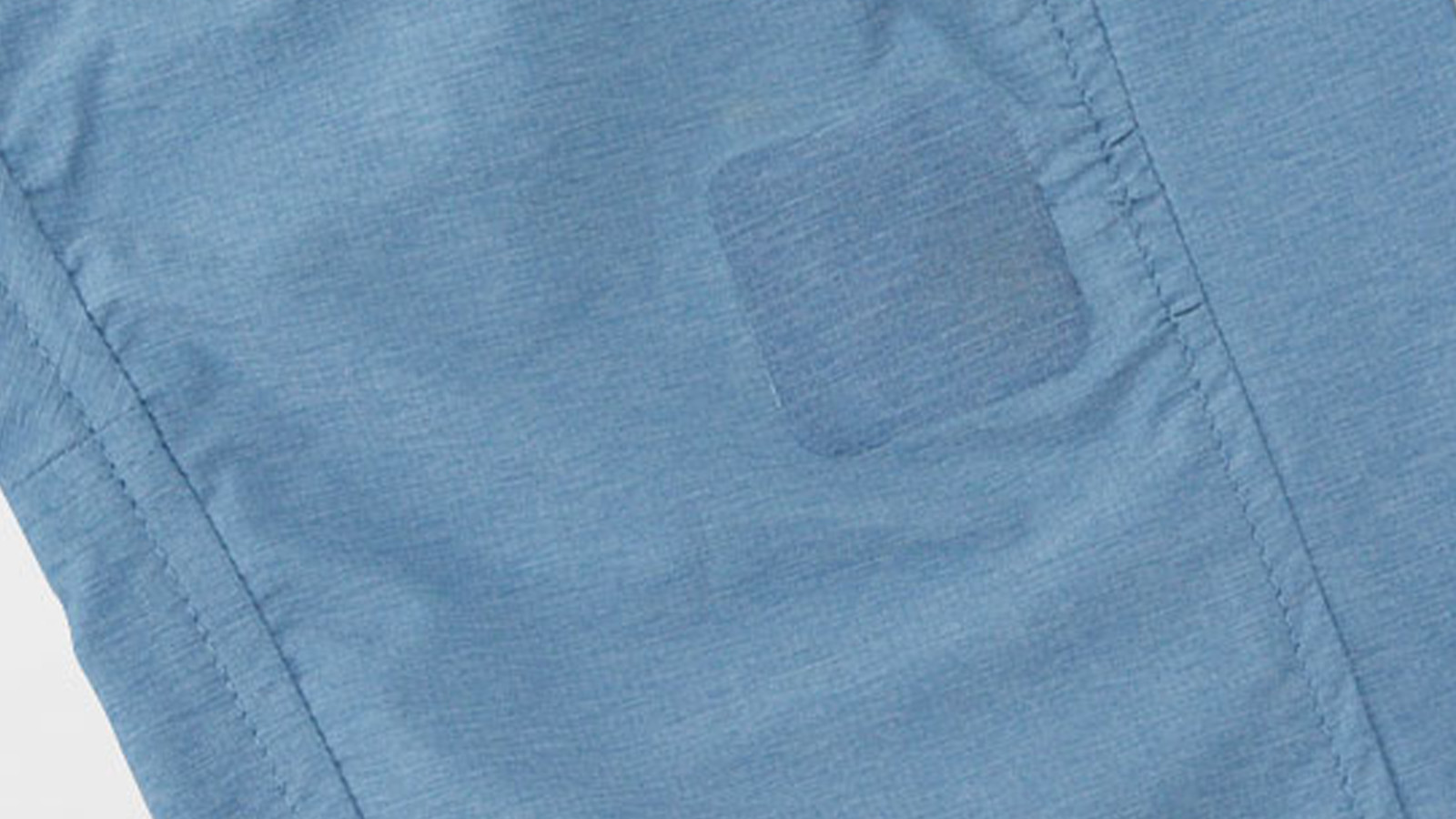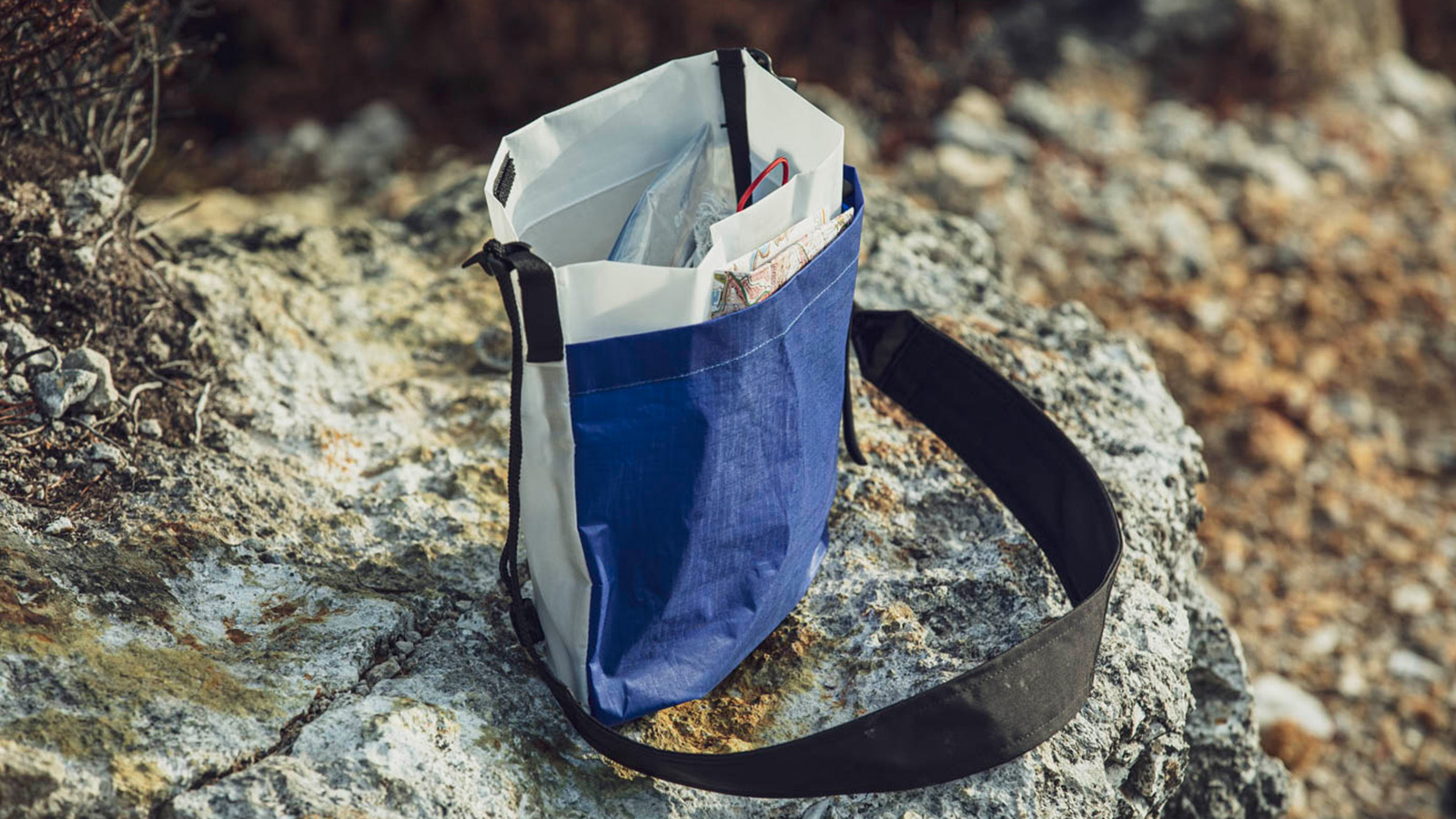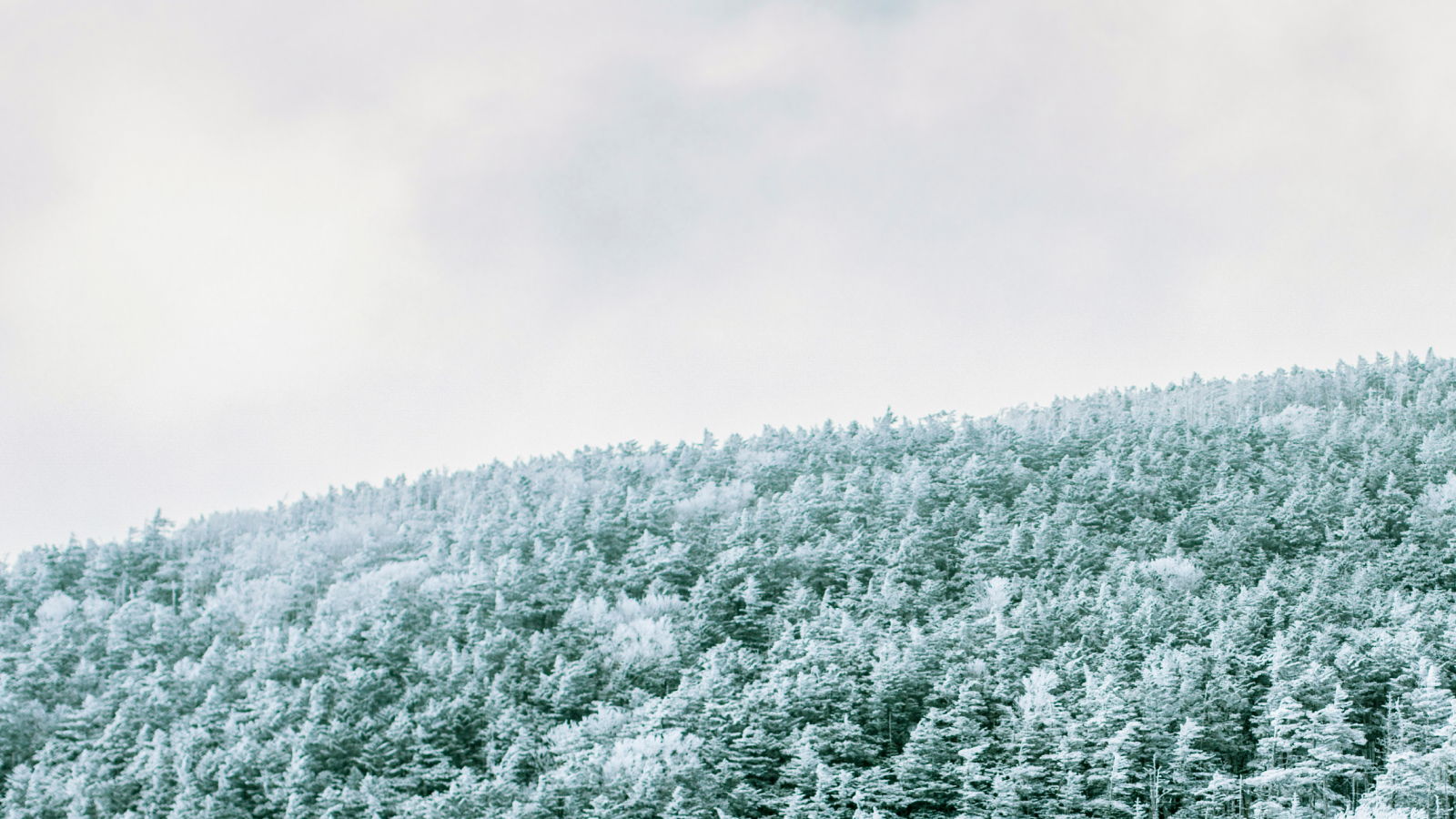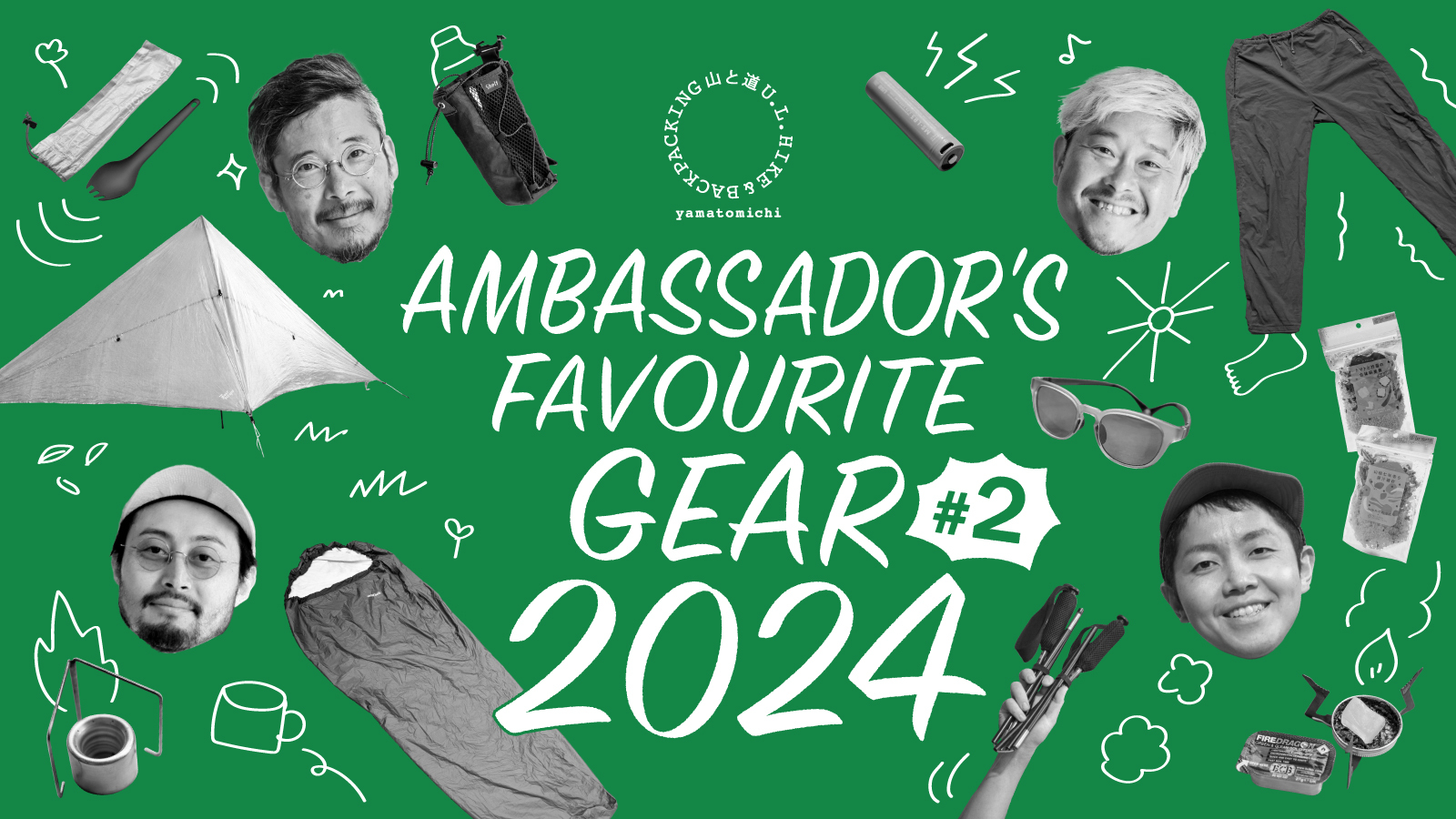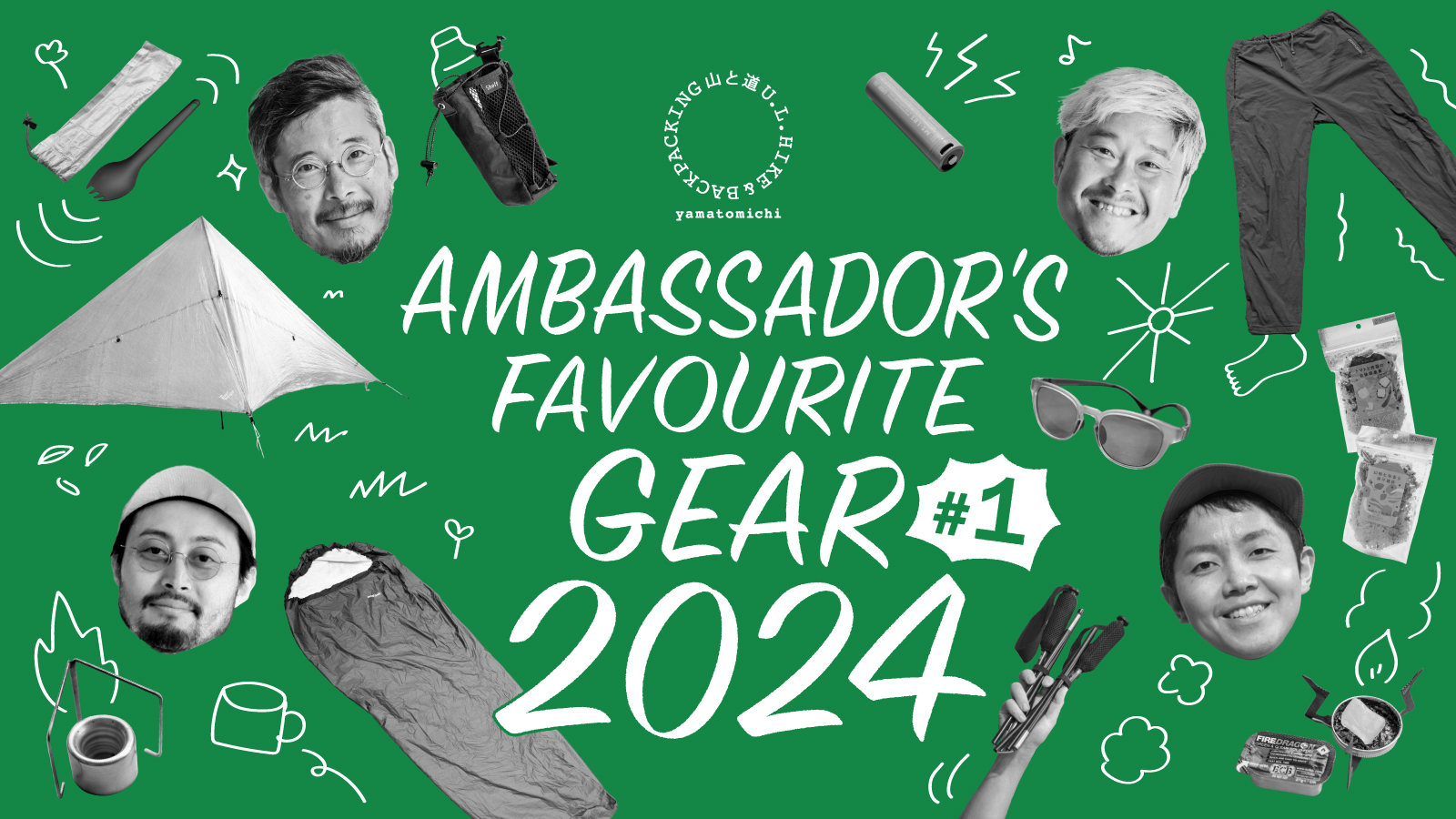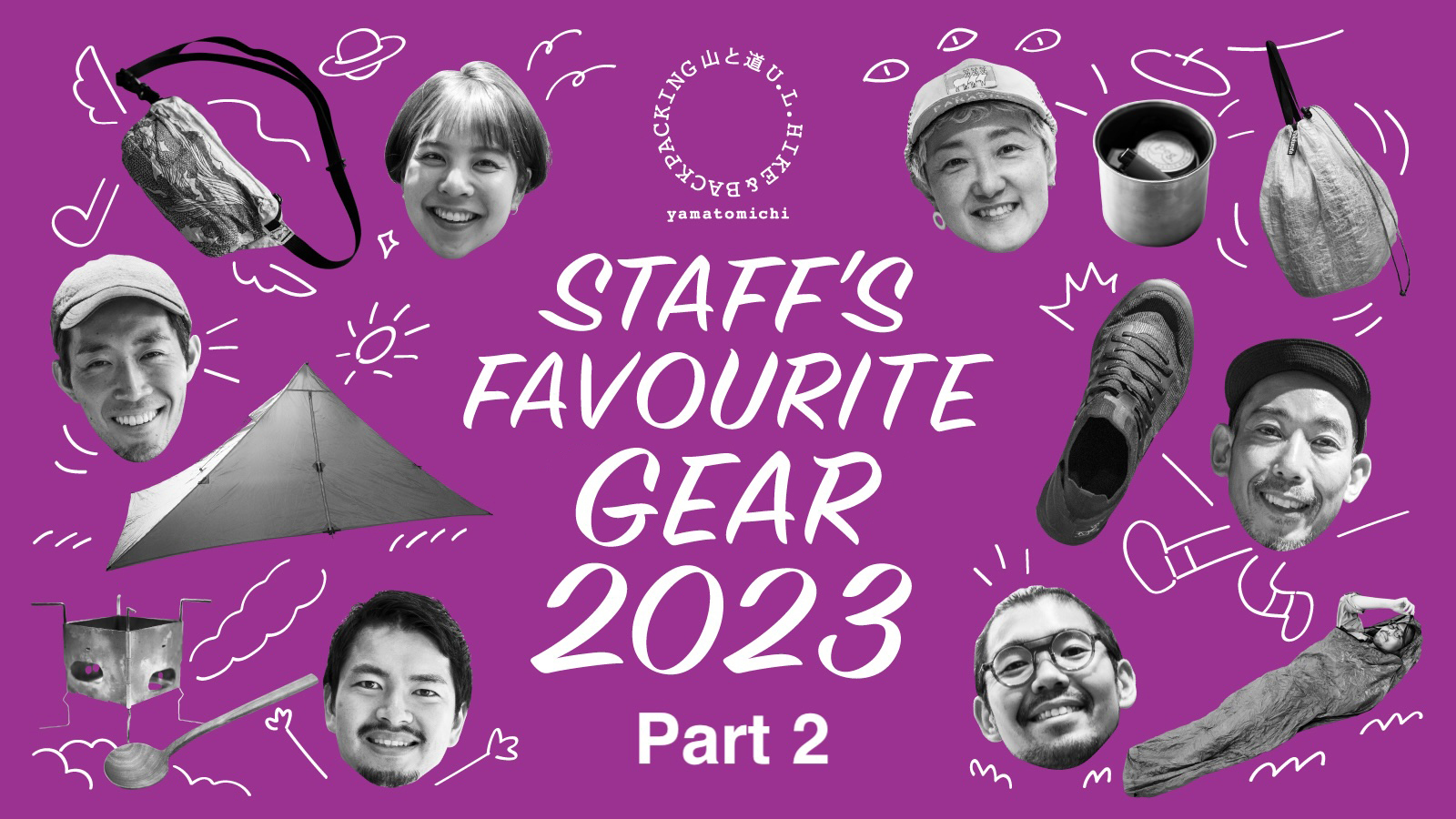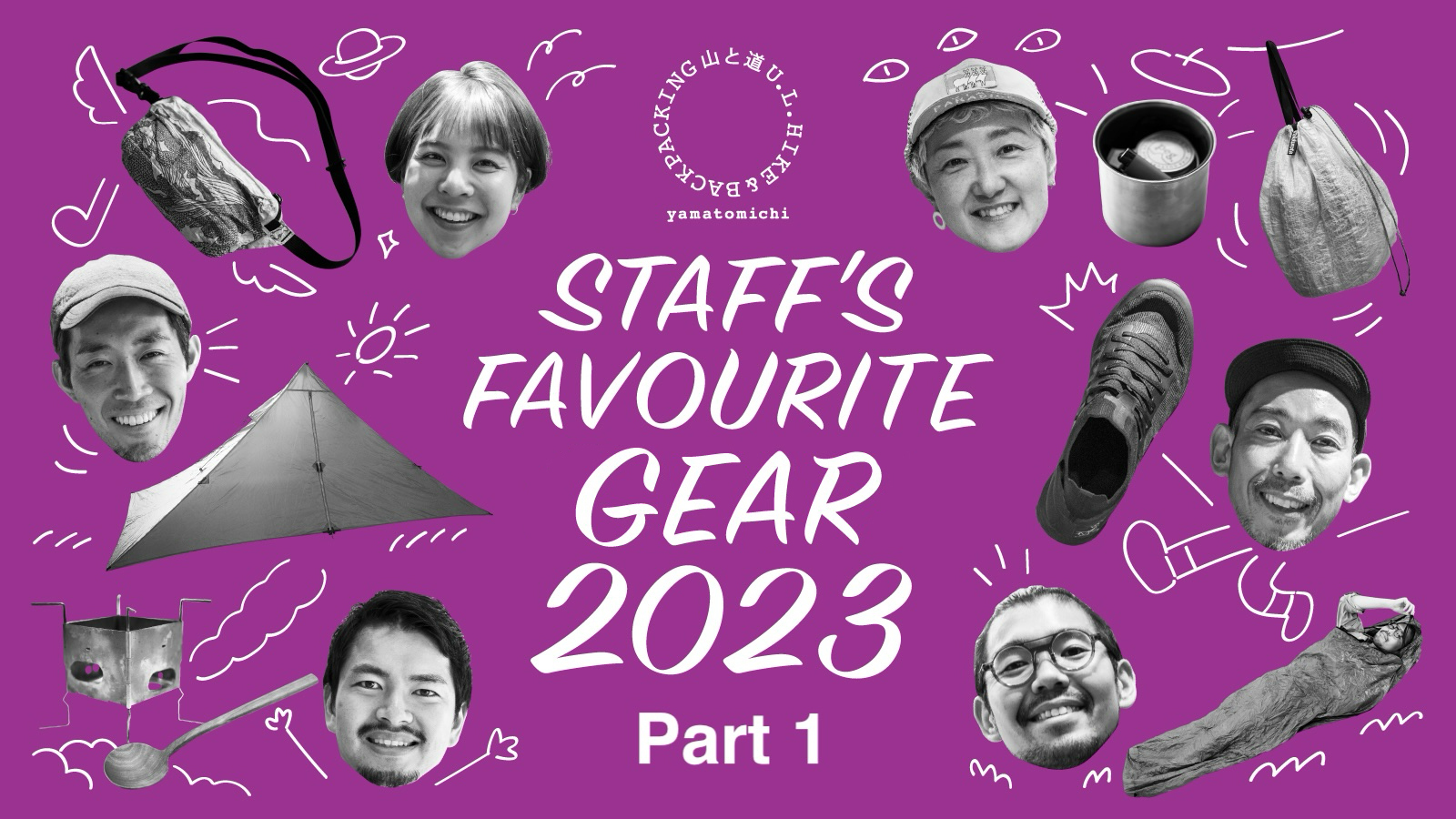Yamatomichi Kamakura Shop Staff #1
Support: Seimi Rin
Yamatomichi Kamakura Shop Staff #1
Support: Seimi Rin
In the hiking community, there are plenty of gear nerds who love to talk about their stuff. Yamatomichi employees are no exception. Recently, we asked the staff at Yamatomichi Zaimokuza in Kamakura and Yamatomichi Kyoto to tell us all about the things they can’t do without on the trail. Our employees aren’t all seasoned ultralight hikers. Some are long-trail thru-hikers; others are outdoor novices. For the two-part first installment of this series, Yamatomichi Journals’ Masaaki Mita gets the lowdown from three members of Yamatomichi Zaimokuza’s staff: Hidenori Maehara (store manager), Ayumi Uesugi and Stephen Moss.
Photos and text by Masaaki Mita
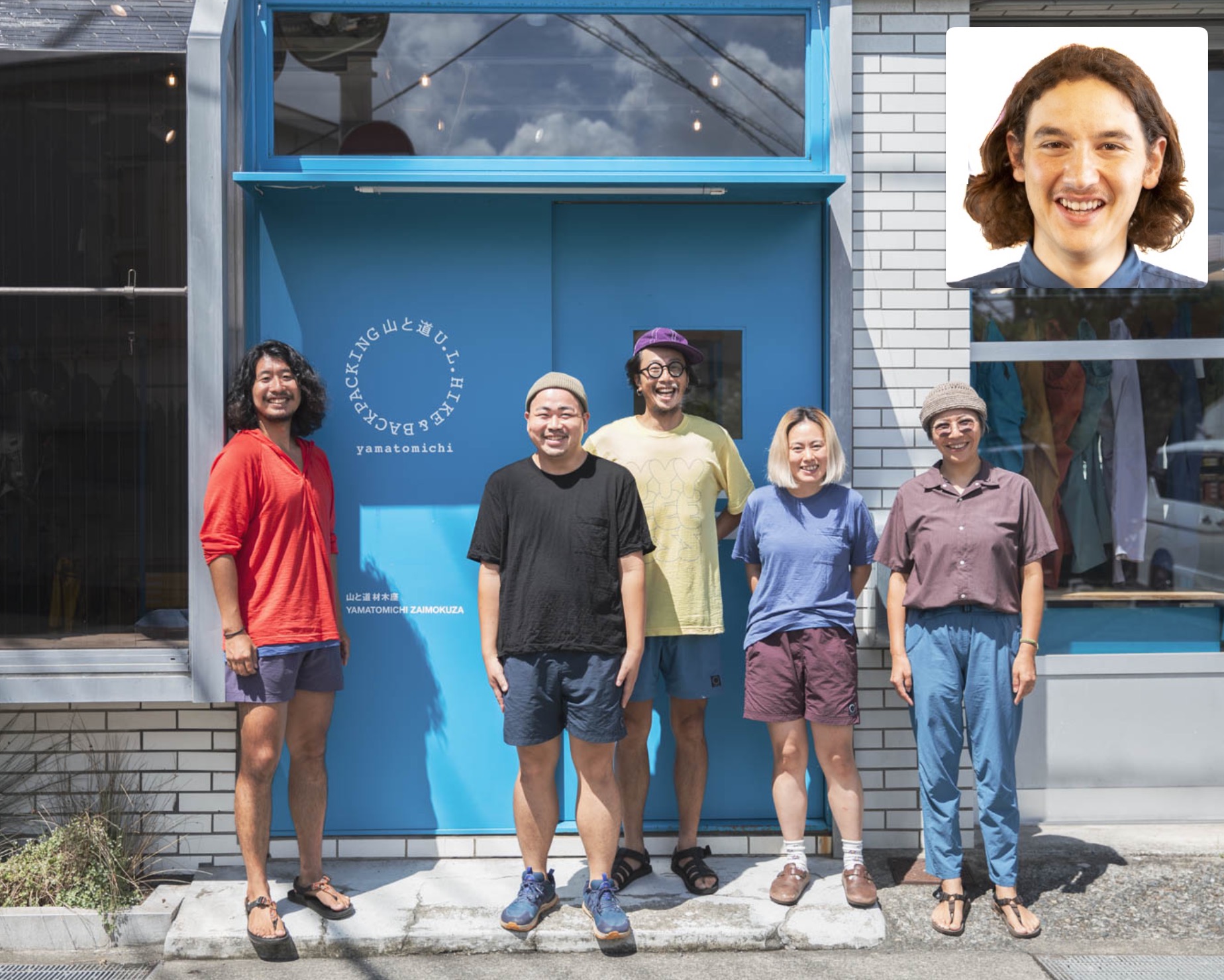
Yamatomichi Zaimokuza’s staff (L to R): Hidenori Maehara, Yuhi Yokoi, Oji Sonoda, Ayumi Uesugi, Yuko Tsunoda, and Stephen Moss (top right).
Hidenori Maehara's Recommended Gear
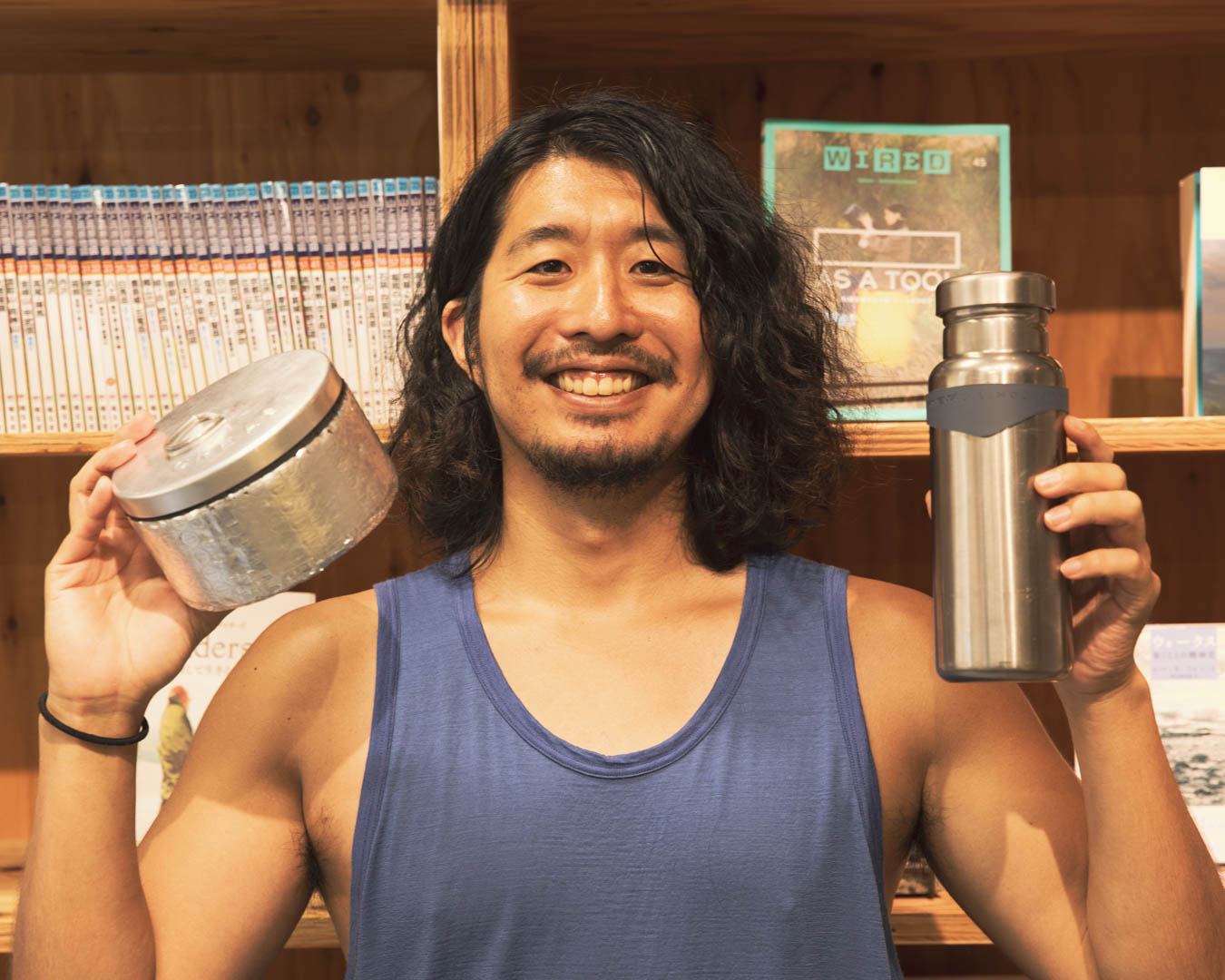
Hidenori Maehara is Yamatomichi Zaimokuza’s store manager. Raised in rural Hokkaido, Maehara worked as a physical therapist at an orthopedic clinic and later maintained a mountain hut in Japan’s Northern Alps. In 2019, he and his wife spent four months hiking the Te Araroa, New Zealand’s 3,000-km trail. He’s since become deeply immersed in the ultralight hiking culture, which aims to minimize strain on both the body and the environment.
Traversing New Zealand
— Introduce yourself, please.
I’m Hidenori Maehara, the store manager at Yamatomichi Zaimokuza in Kamakura. Besides my managing duties, I handle various tasks at Yamatomichi, and I look after Hike Life Community (HLC) Kamakura.
Q: You’re involved in quite a lot. How long ago did you join Yamatomichi?
HM: It’s been almost two years now.
Q:: You’ve had such an intense experience during your time here.
HM: Yes, I have! I’ve had a lot of enjoyable experiences and also took challenges.
Q: When did you start climbing mountains?
HM: Around 14 years ago, during my freshman year at university, I climbed Mount Takao with my elder brother. I think that was the year Michelin added Mt. Takao to its guide, so we decided to go and it was great. But it wasn’t until after I graduated and started working that I got serious about gear and hiking.
Q: That was around the time Japan was experiencing a hiking boom?
HM: Yes, exactly. My soon-to-be-wife and I were dating. She’s from Yamanashi prefecture, so she had been climbing mountains since she was little. We started going on camping trips. At that time, we were both working as physical therapists, but we decided to quit and worked at a mountain hut for a season. After that, we walked the 3,000-km Te Araroa, across New Zealand, and then we joined Yamatomichi.
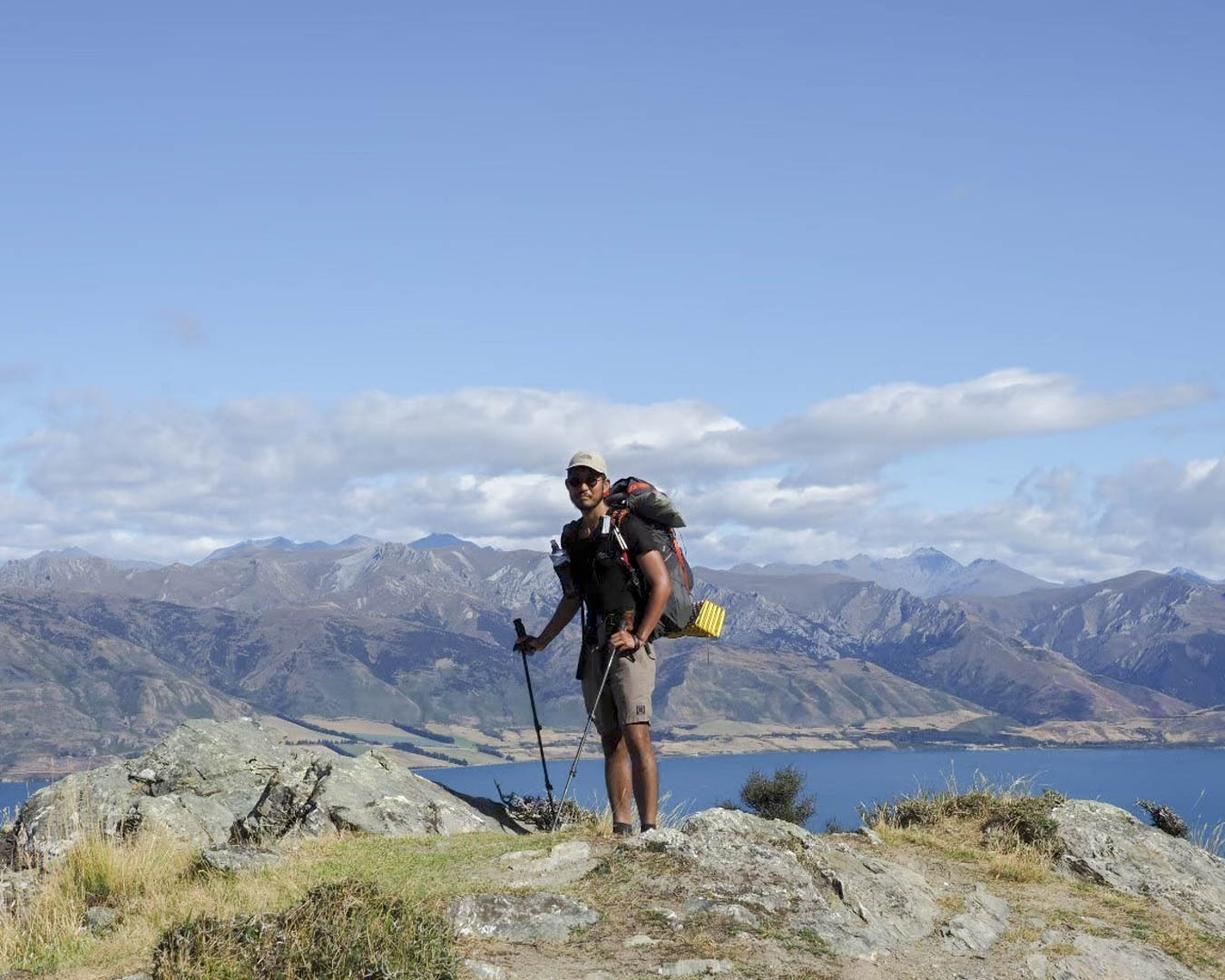
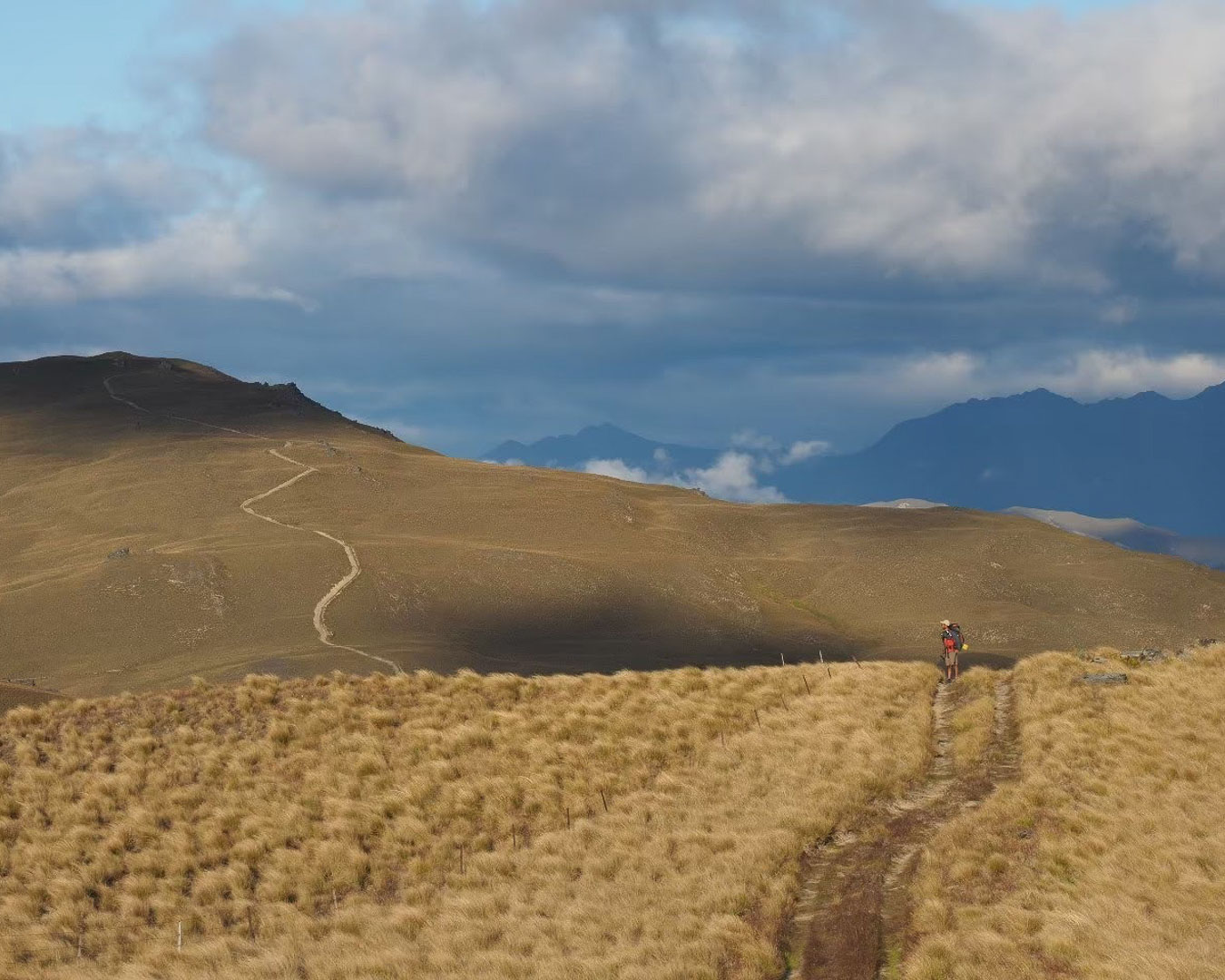
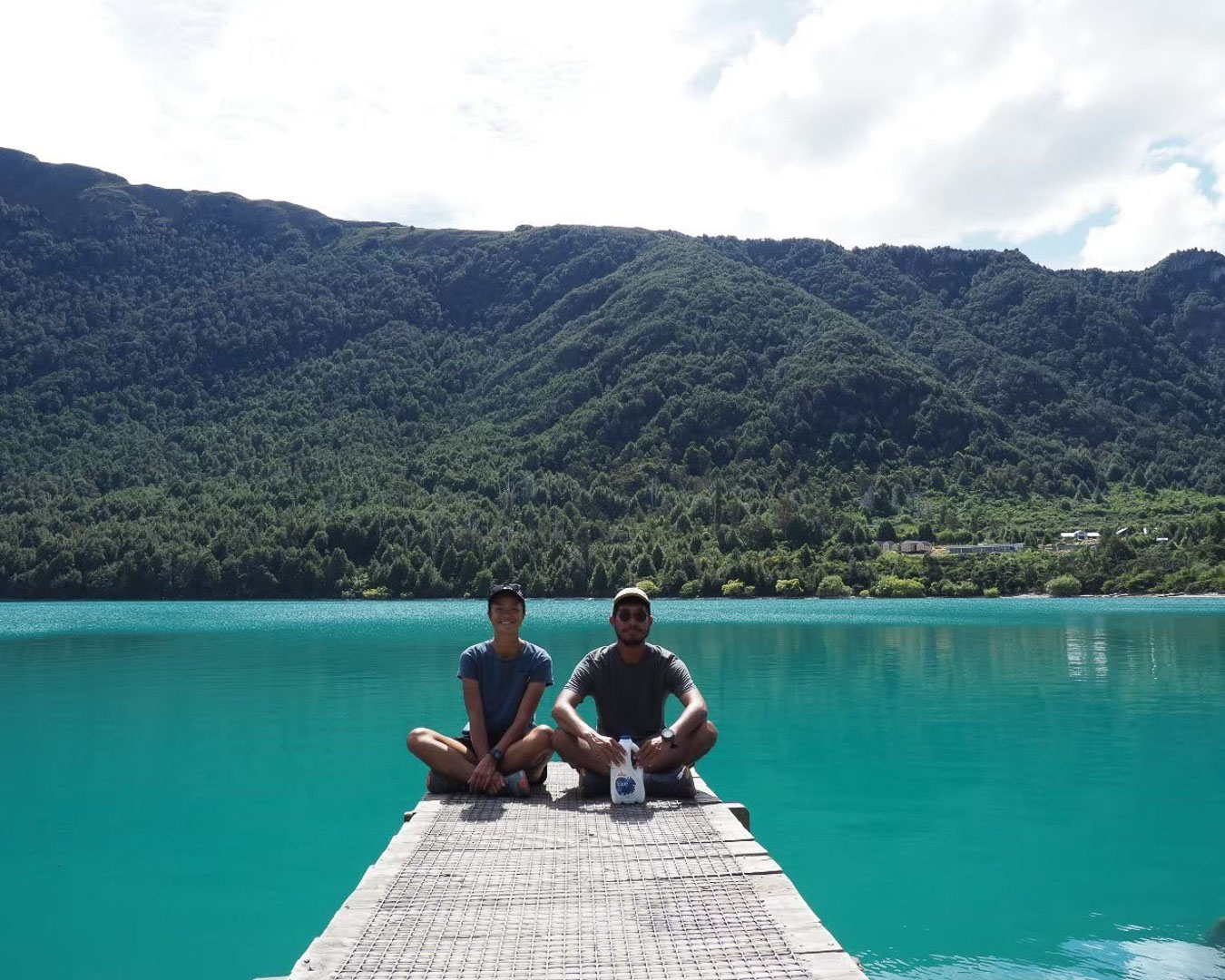
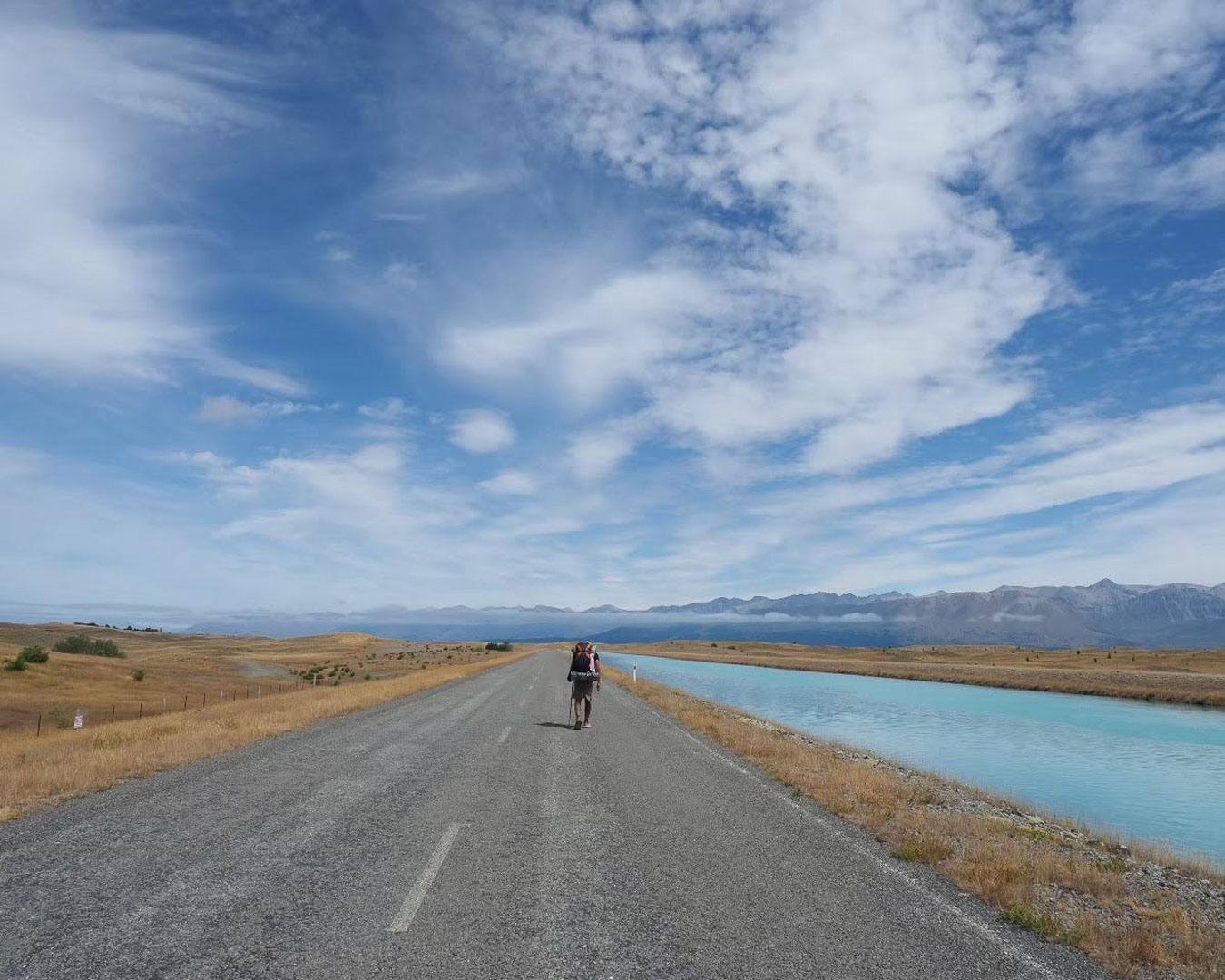
Q: Was the Te Araroa trail experience significant?
HM: Definitely. The allure of long trails is that walking –– everything on the trail, really –– is part of your daily life. Your home is your backpack, and your job is to walk. Calling it a job might sound misleading, but I had a lot on my mind at the time, and for me, walking the Te Araroa was a wonderful time when everything became clear and simple. The natural parts of New Zealand and the relaxed pace of life there reminded me of my hometown in Hokkaido. I felt like I’d gone back to my carefree childhood. I wasn’t yet using ultralight gear but the four months of continuous walking and the process of simplifying my tools and adopting the survival mindset had a positive influence on how I live and hike now. Long trails are great!
1. Maxi Titanium Water Bottle
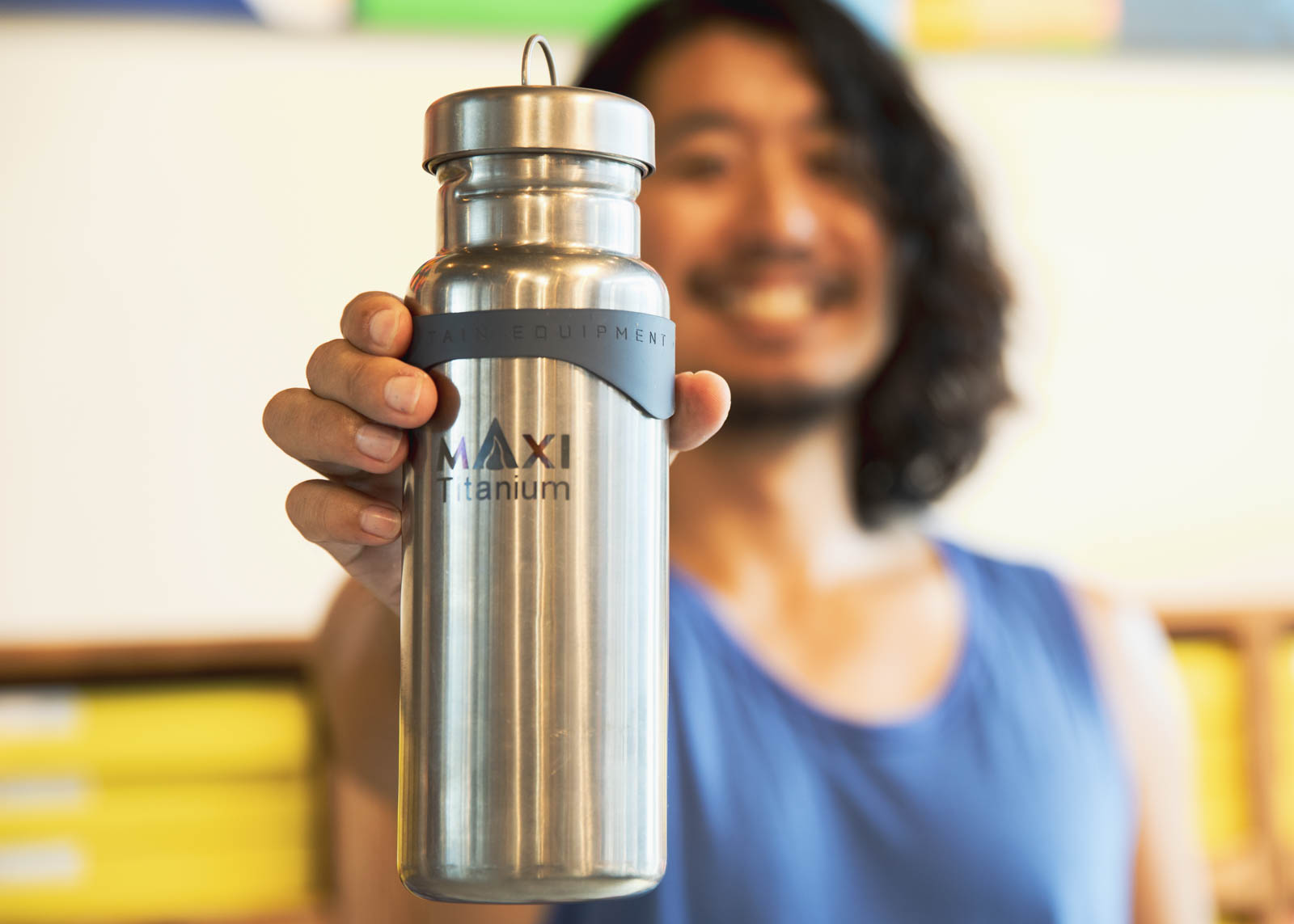
Q: Could you tell us about your favorite hiking gear?
HM: First, a recent favorite: the Maxi Titanium water bottle. I bought it at a shop in Matsuyama (Ehime prefecture) called T-mountain, on my way back from the recent Yamatomichi Festival.
Q: Titanium bottles are often double-walled, insulated bottles, but this one is intentionally single-walled, right?
HM: 800 ml. It’s the perfect size. Except for midsummer, one bottle of this size is enough. And since it can be used on a fire, if your meals consist of dry food, you don’t even need to bring cooking equipment.
Q: It’s interesting that you can use the same bottle for drinking water and boiling water once you’re at your campsite. Isn’t it too hot to hold after putting it on the fire?
HM: Which is why I use an Evernew Flameproof Silicone Ring.

Q: Doesn’t the silicone band get hot?
HM: It does, if it’s too close to the fire. But this bottle is quite tall, so it’s fine. A plastic water bottle would be lighter, but since my titanium bottle also doubles as a cooker, it reduces the number of items I need to carry. And to me, that’s very ultralight.
2. RiverSideRambler RSR Nature Stove 30
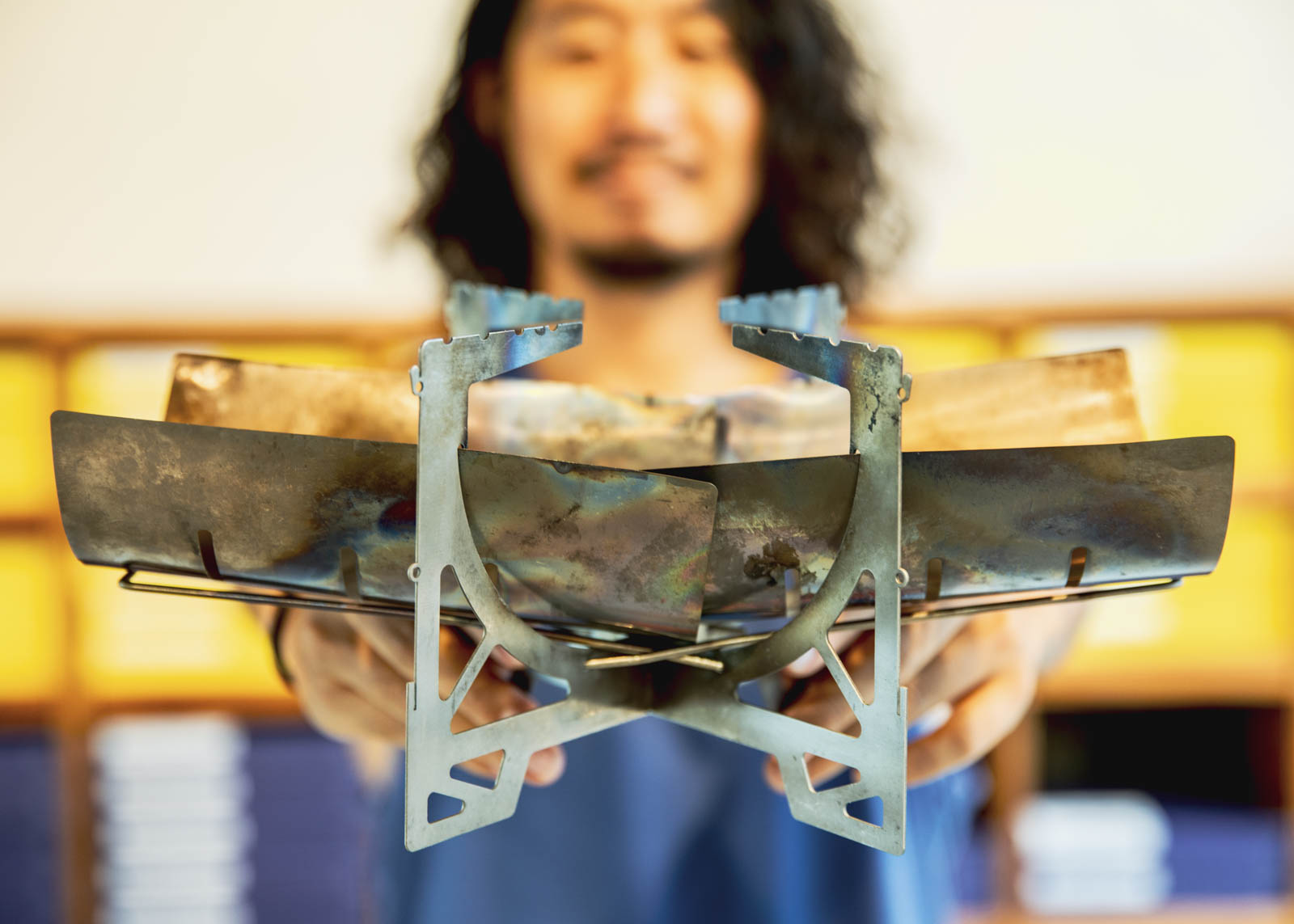
Q: What’s your next favorite piece of equipment?
HM: Next is the RSR Naturestove30. Originally, this stove was available as an optional kit for a fire pit that could handle thick logs, but now it’s also sold as a standalone product.
Q: By attaching these titanium panels to the frame of the RSR Nature Stove, the whole thing transforms into a fire pit? That’s interesting. For lightweight, compact fire pits, the PicoGrill 398 sets the standard, but the RSR stove has its merits. It feels sturdier and more stable compared to the PicoGrill.
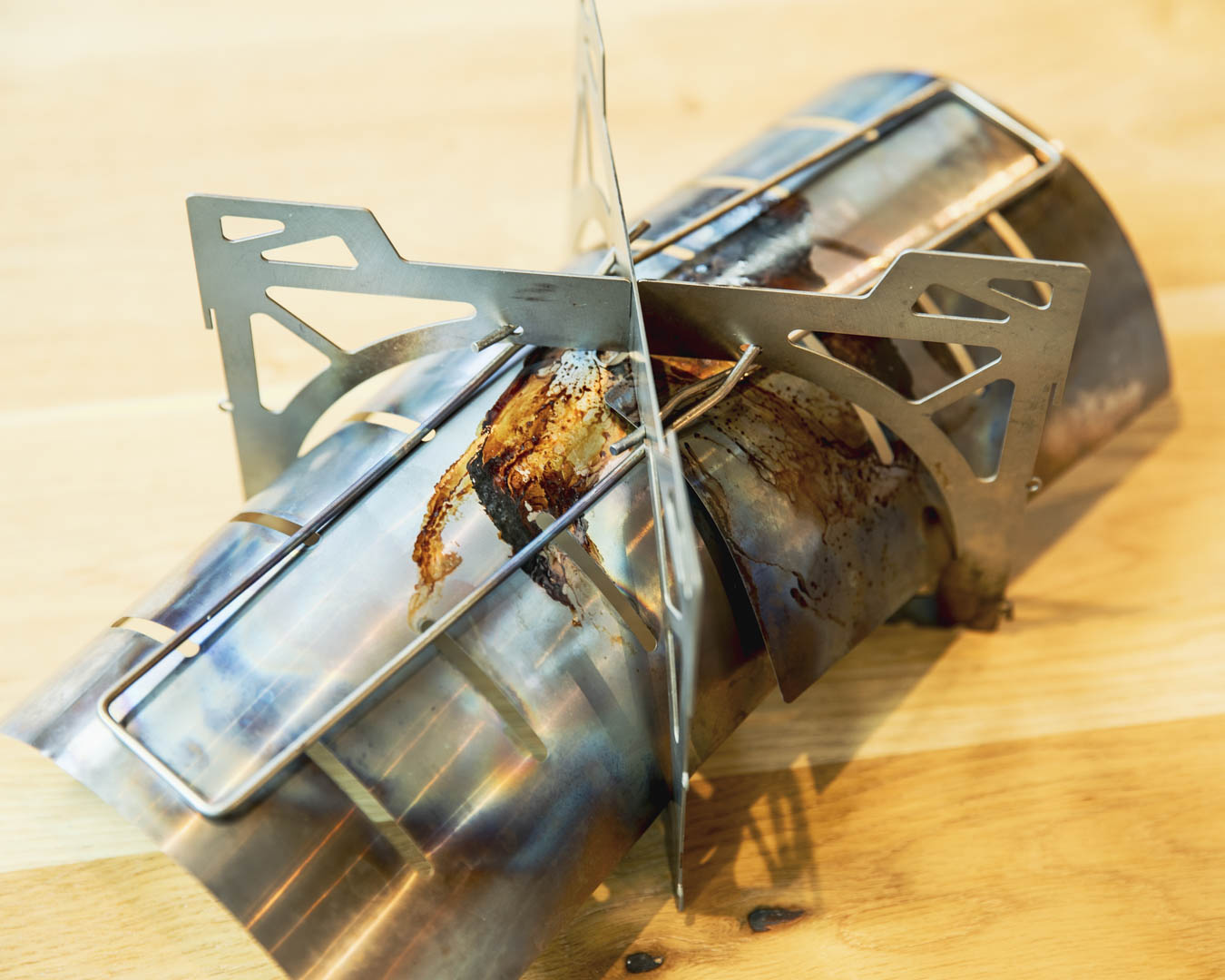
底面にはステーを噛ませてがっしりと火床を支えている。
HM: It’s just the right size. The RSR Nature Stove can’t handle thick logs and the firebed is mesh, so ash falls through. I bought this option kit, and it’s been mainly what I use.
Q: It seems smaller than the PicoGrill 398. The PicoGrill is big enough for four to five people, but this one seems like it would be sufficient for two to three people to stay warm. How much does it weigh?
HM: 182 g, which is half the weight of the PicoGrill 398’s 398 g.
Q: That’s very light.
HM: It might be because the frame is titanium. When folded, it’s about the size of an A5 sheet of paper.

Q: The PicoGrill might feel a bit too big for solo use, but with this one, I’d be inclined to take it even when I’m alone.
HM: It doesn’t get in the way when it’s in your bag. It’s light and compact enough to bring along even if you’re not sure you’ll use it, yet it can still burn thick logs.
Q: At 182 grams, isn’t this one of the lightest fire pits for groups? There’s also Sola Titanium Gear’s Super Naturestove #1, but that one feels really like a solo option, and the firebed is mesh. This one is quite tempting.
HM: Personally, I recommend this one because it can handle larger logs compared to the regular RSR Nature Stove.
Q: The RSR Nature Stove is more of a cooking tool than a fire pit. While it’s an amazing piece with tremendous heat output due to its chimney effect, it’s better for cooking.
HM: It’s better for cooking, but this one can handle both cooking and having a fire.
3. Wanderlust Equipment Grease Pot Cozy Kit
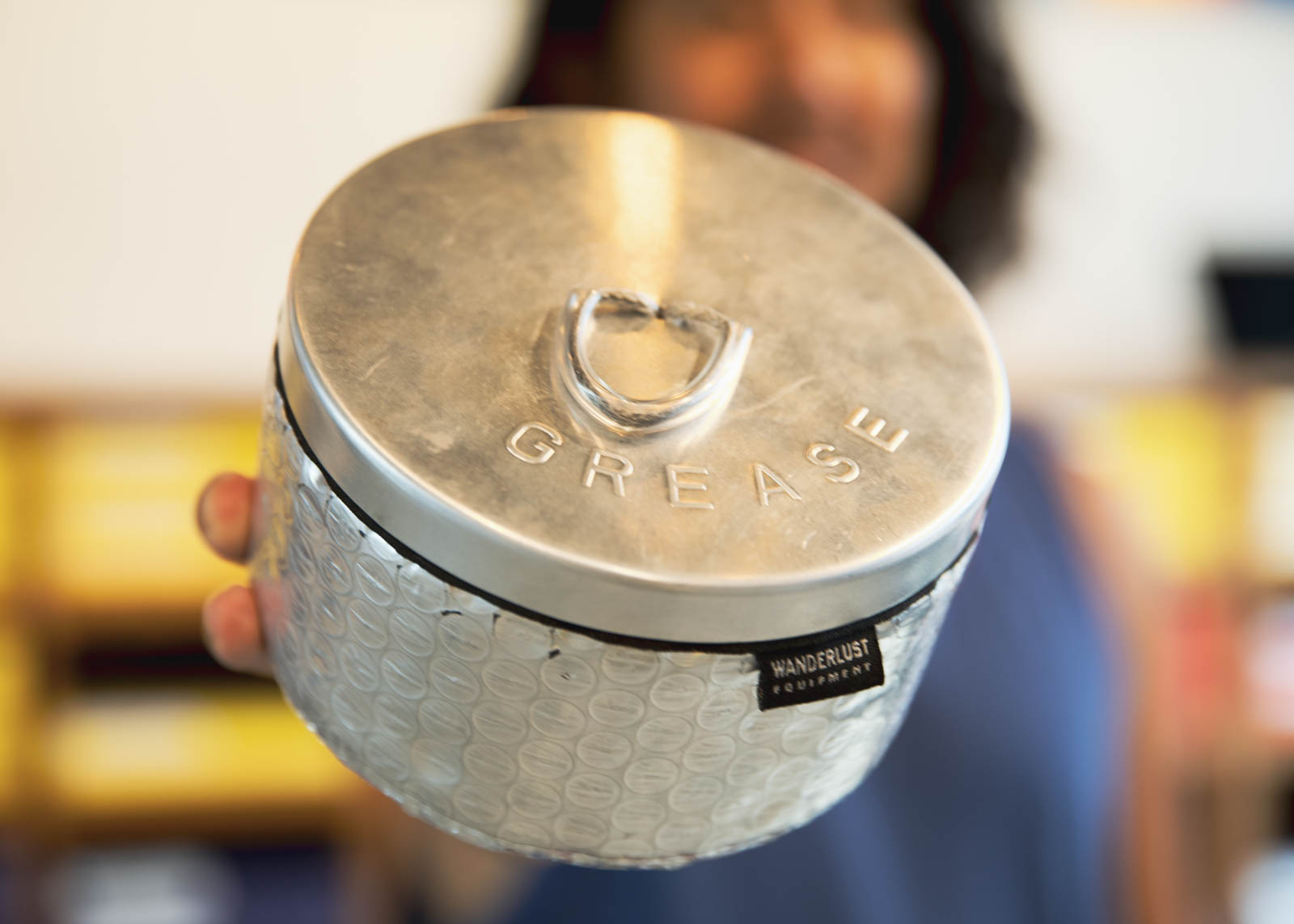
Q: Mr. Motoyasu Kawanobe (RiverSide Rambler’s founder and product designer) would probably suggest buying both. What’s next?
HM: The Wanderlust Equipment Grease Pot Cozy Kit. Rather than as a standalone item, I’d like to talk about it as part of a stacking system.

Q: The Grease Pot was originally a cheap aluminum pot from the US. Because it’s inexpensive, it’s very thin, incredibly light, and the size is just right, making it a classic choice for ultralight hikers.
HM: It wasn’t originally designed to be used as mountain gear. But it’s incredibly light. Despite having a capacity of about 900 ml, the pot itself weighs just around 100 g. The lid handle is large and bulky, so DIY manufacturers often replace the lid with a smaller one and sell it. This is a set from Japan’s Wanderlust Equipment that includes a lid with a lightweight handle and an Astro Foil cozy (lightweight, efficient insulators that help hikers save fuel by keeping food hot enough to keep cooking after it’s taken off a stove). The size is perfect for making instant noodles and other dishes.
Q: I usually carry a 500 ml cooker, but if I were to buy a larger one, I have my eye on the Grease Pot.
HM: Also, the fact that aluminum has good heat conductivity is a plus. It’s often paired with alcohol stoves. A titanium pot conducts heat poorly and wastes fuel.
Q: How is the Wanderlust cozy?
HM: I use it more often in combination with the MSR DeepDish Bowl rather than the Grease Pot. The bowl fits perfectly with both the Grease Pot and the cozy. I use the pot only for boiling water, not to eat out of.
Q: A cozy and cooking utensils can feel like a luxury with ultralight gear, but when they fit so well together, you want to bring them along.

HM: And this T’s Stove MesTi Peg Windshield is perfectly sized for the Grease Pot, and stacks neatly and compactly.

Q: The reason I don’t really like alcohol stoves is that they require a lot of accessories like windshields and pot stands, which makes them cumbersome. But this one has the windshield and pot stand integrated, and it seems very stable. In Japan, T’s Stove was a pioneer in alcohol stoves and its products even sold in the U.S. as an early Japanese ultralight DIY manufacturer, but they seem to have closed down a few years ago. It’s a shame these are no longer available.
HM: That’s right. I forgot to bring the Evernew alcohol stove today, but it fits into the whole setup neatly.

Q: The way this stacks is great. I wasn’t that interested in stacking before, but now I want to try it myself.
HM: It feels great when everything fits perfectly.
4. New-HALE Emergency Tape and Original Emergency Kit
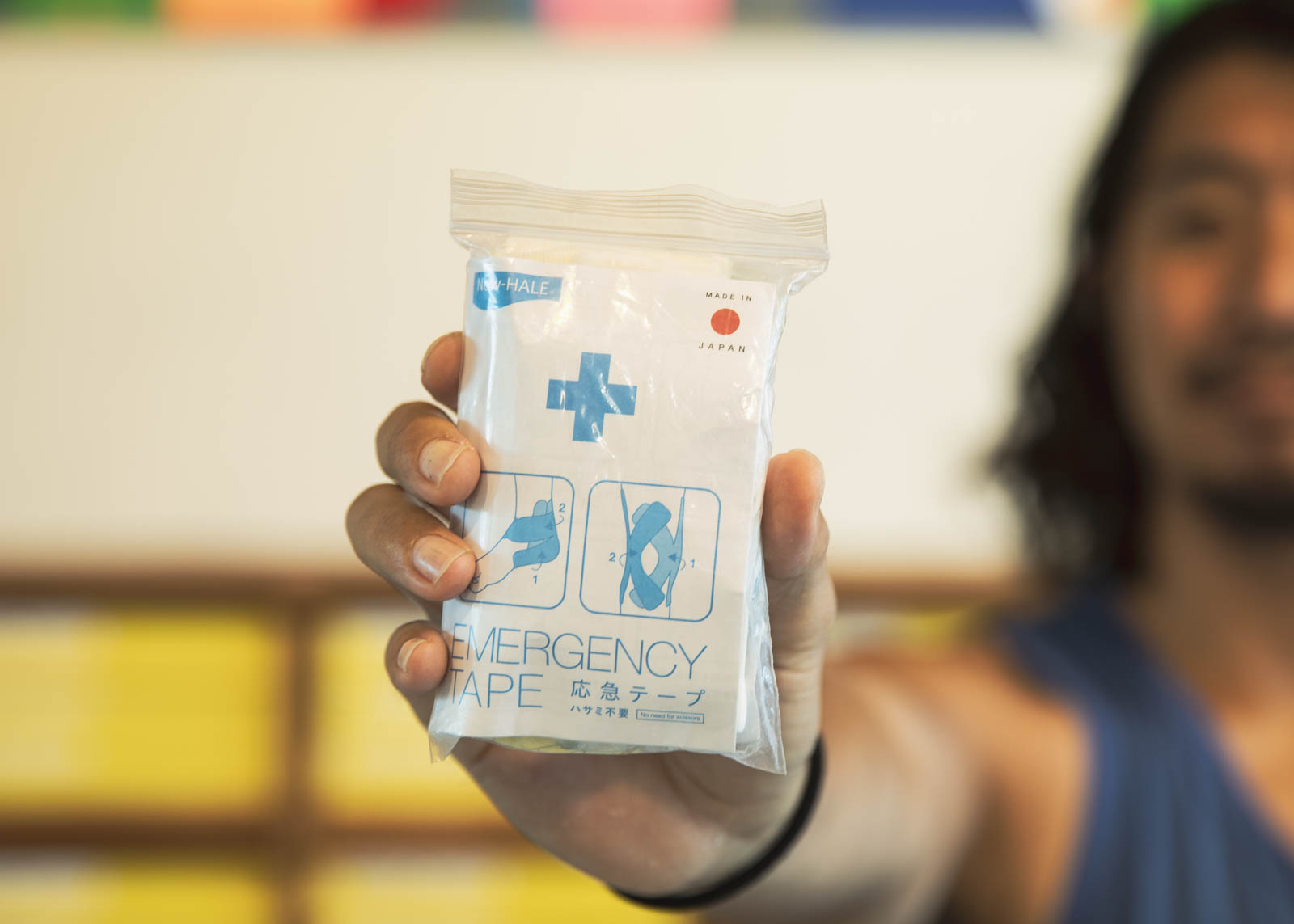
Q: So, what’s next?
HM: Next is New-HALE emergency tape. Not the tape on its own but as part of a customized emergency kit. I learned about this from Hiroshi Taketani at New-HALE, who lives nearby in Hayama. It’s a set of four strips of emergency tape with a bag that has extra space, so you can add other things –– rubber gloves, band-aids, painkillers and cotton swabs –– to make a minimal emergency kit.

HM: The tape is also quite strong when you stick the adhesive sides together, so you can use it for temporary repairs. For instance: if the sole of your shoe comes off. The instructions tell you how to use the tape, and the material it’s made of is tough, so I’ve heard you can even use it as a splint if you break a finger. The rubber gloves can also be used for warmth when it’s cold or they can be filled with water for an ice pack.
Q: If you want to make it even more compact, you could take along fewer tape strips or leave out the instructions.
HM: It’s just a few items, but they can be used in many different ways. So I feel that this is enough and I take it everywhere I go.
4. Tarptent StratoSpire 2
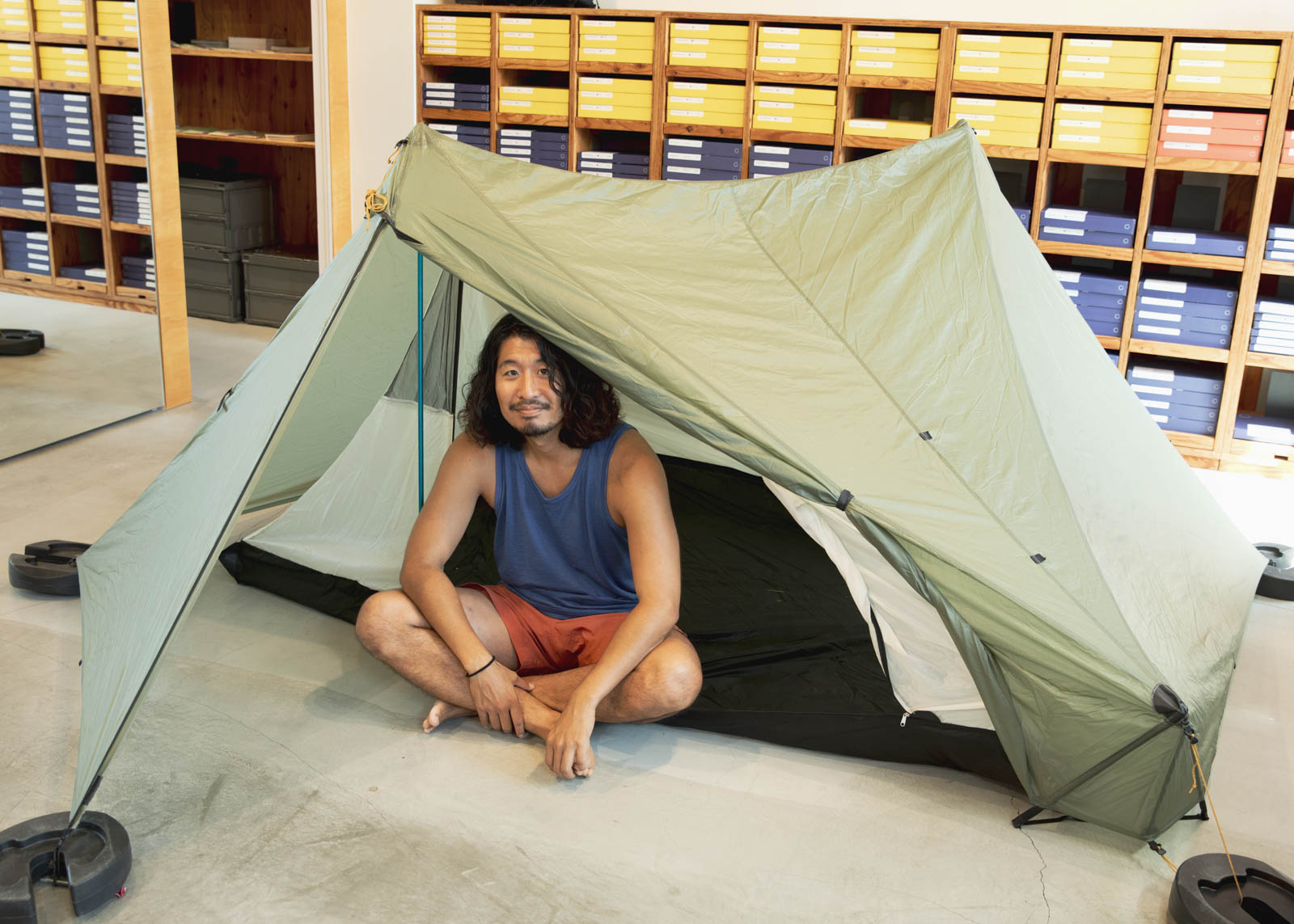
HM: The last item is the Tarptent StratoSpire 2.
Q: This is for two people?
HM: It’s for two people. It’s quite spacious, so there’s plenty of room. I have the older model; there’s a new, updated version.
Q: Is this the one you used on the Te Araroa trail in New Zealand?
HM: Yes. It absorbed all of the smells from that trip.
Q: This is frameless and can be set up as a double-walled tent, right?
HM: Yes, you prop it up with two trekking poles, and the inner tent is suspended. You can set it up very quickly, in just two to three minutes. The whole thing weighs about 1.2 kg, which is light for a two-person double-walled tent.
Q: This is very much in line with Tarptent’s quality.
HM: It’s beautiful. The shape and the features are amazing.

Q: The way the bottom stands up also shows their attention to detail. It feels like it’s absolutely necessary.
HM: Also, the poles are positioned off-center, creating two high points, which makes it comfortable to stay under.
Q: Inside, you sleep diagonally. That’s interesting.
HM: This was the only one of its kind at the time. It looks like a hexagon from above, and you sleep diagonally inside.
Q: It’s well designed. Tarptent’s co-owner and designer, Henry Shires, really loves tents, and you can tell.
HM: There’s a steady stream of new tent design releases.
Q: There are already so many types already, and yet they keep releasing more. He must be thinking about tents all the time.
HM: The frequent updates are impressive.
Q: What’s it like using one?
HM: My wife and I used this in New Zealand for about four months. When you’re sharing such a small space, even as a couple, you need some personal space. But this tent has enough width that we didn’t bump into each other while sleeping. And the vestibule is quite spacious, so there’s no stress when cooking even if it’s raining.
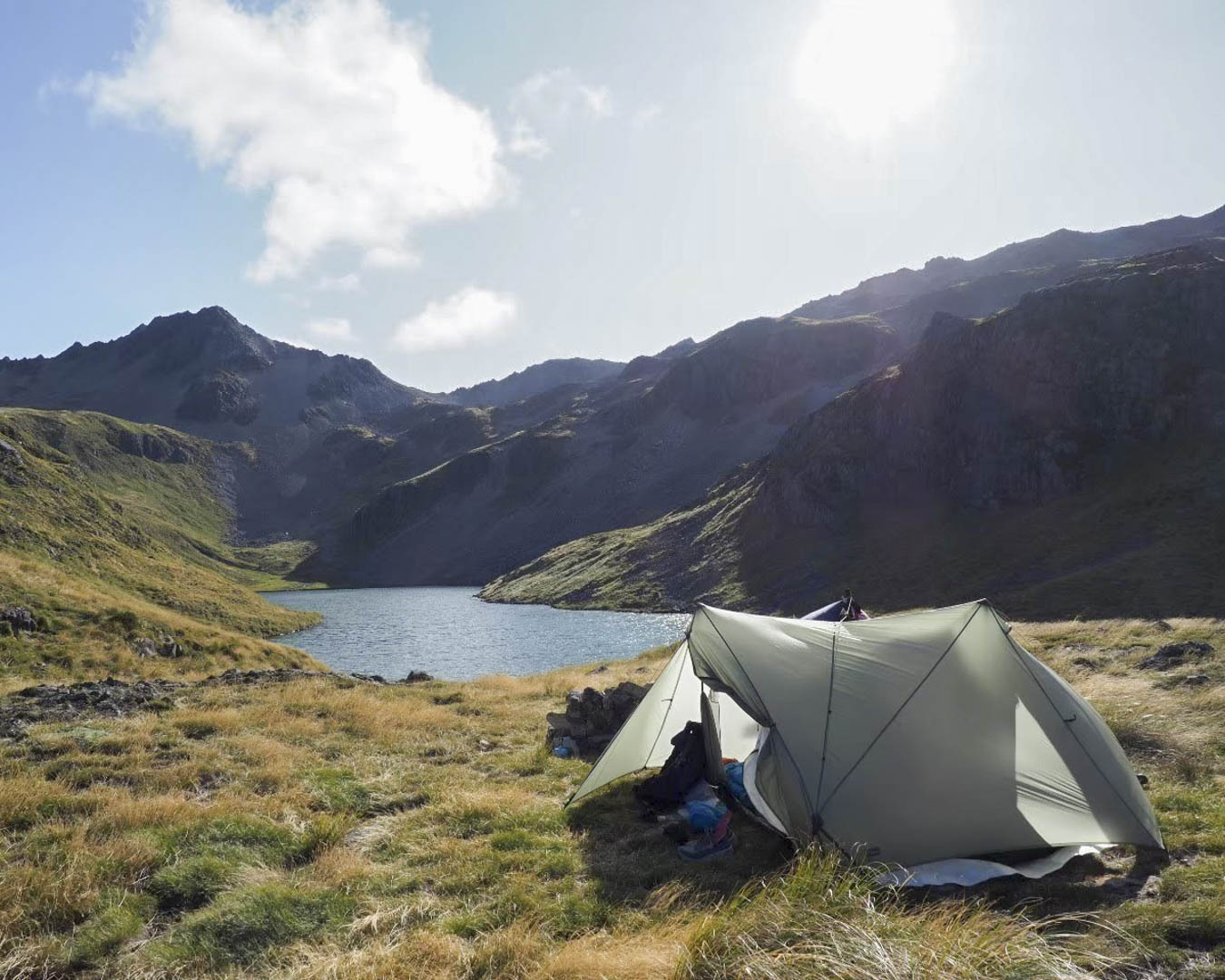
Q: And it has two entrances, at the front and back, so there’s a vestibule on both sides, right?
HM: Exactly. For example, if you need to go to the bathroom at night, you can use either side without having to step over your partner. If I were to point out one drawback, it’s the size: It’s too big for the mountains in Japan.
Q: It seems too big for campsites in the Japanese Alps.
HM: It’s a bit hard to use there. When I lived in Hokkaido, there was plenty of open space, so I used it a lot. But I stopped using it since moving here.
Q: It seems to have the floor space of a four-person tent.
HM: Last year, when my colleague and I participated in the Original Mountain Marathon (OMM), we removed the inner tent and used only the fly. For the two of us, it felt so spacious!
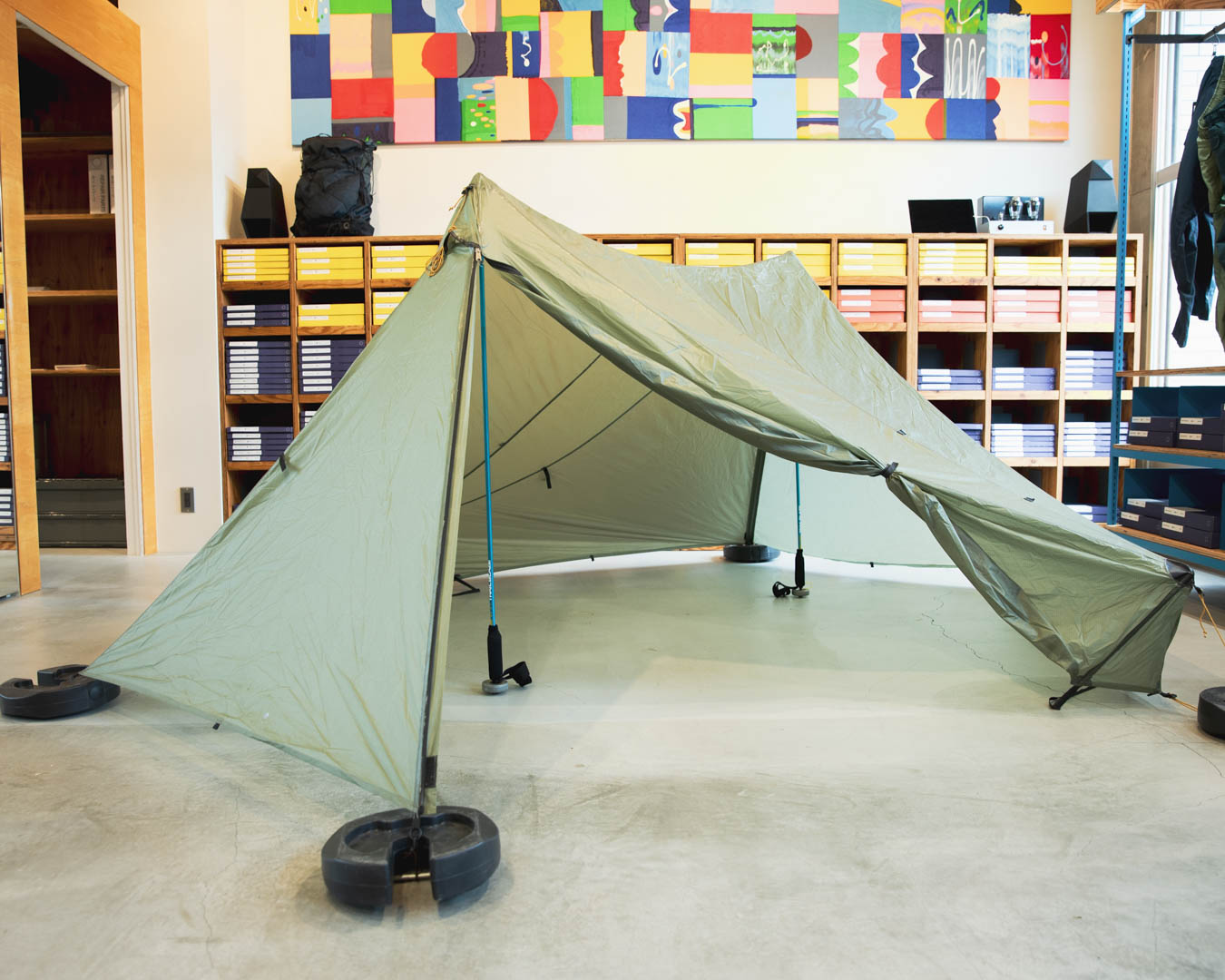
Q: It must be really spacious without the inner tent. It seems like it could even be used as a party tent.
HM: You can fit four people in it. This year, some of our staff will also participate in the OMM, so we’re planning to have a party in this tent. It’s got a lot of wear and tear: A fox in Hokkaido chewed on it and it had to be patched up with duct tape. But it’s full of memories.
Q: It sounds like a tent you could never throw away because of all the memories you’ve had with it.
HM: I definitely can’t toss it out. And since my first child was born this year, I think it will be perfect for family trips to the mountains in the future.
Q: As your lifestyle changes, your gear will probably need to change, too. I think I’ll start considering things like stacking equipment and an emergency kit!
Ayumi Uesugi’s Recommended Gear
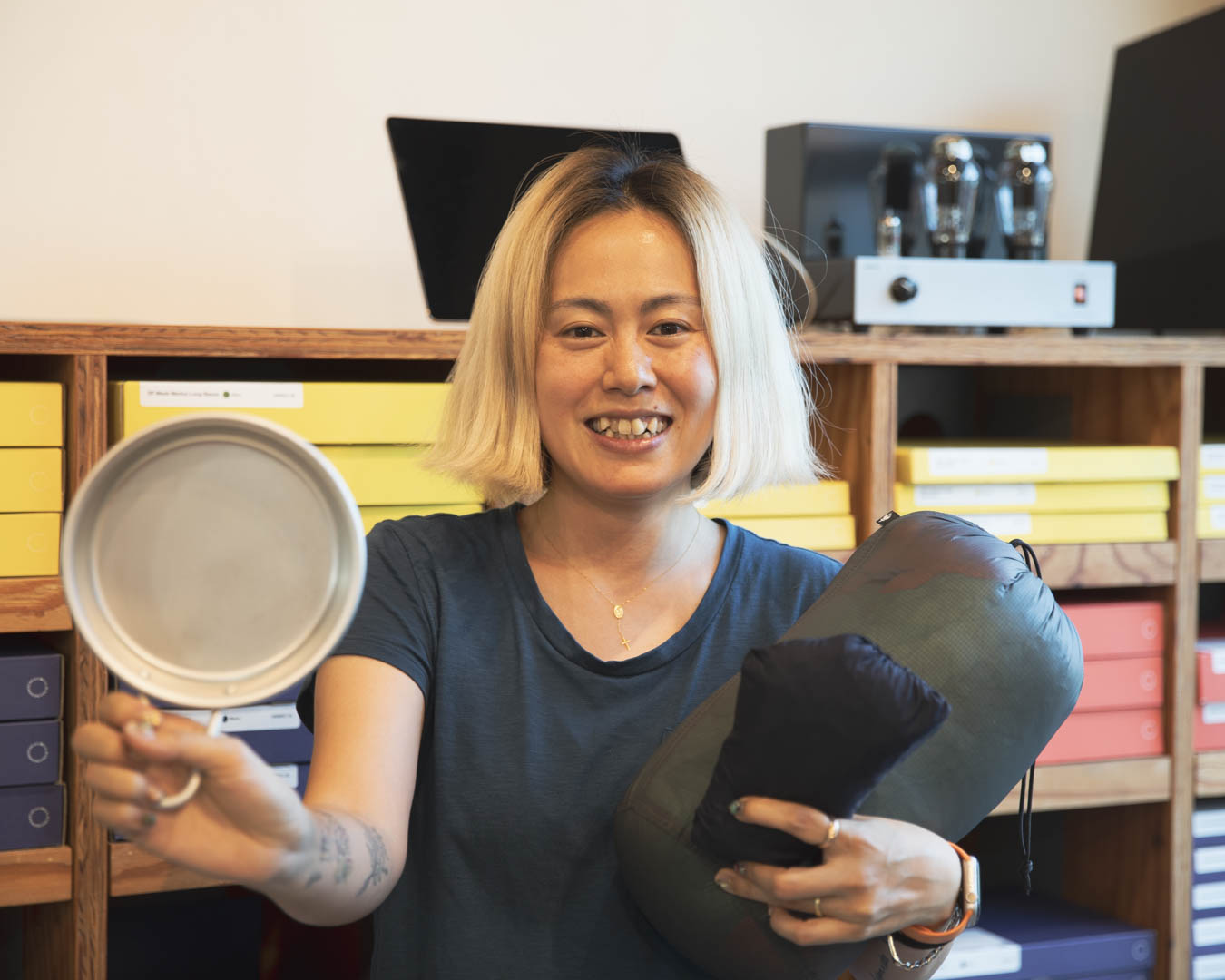
Ayumi Uesugi works at Yamatomichi Zaimokuza’s store. Born in Kanagawa, she attended a vocational school and pursued her dream of working on the tour crew for her favorite music artist. Inspired by her parents’ love for the mountains, she later worked at an outdoor gear manufacturer; a mountain hut in the Northern Alps; and a mountain specialty store before joining Yamatomichi. She enjoys traversing, climbing, canyoning and ice climbing in the mountains but also long-distance moped touring and skateboarding.
Growing Up In the Mountains
Q: Please introduce yourself.
AU: I’m Ayumi Uesugi, and I work at Yamatomichi Zaimokuza store in Kamakura. I’ve been with the company for about a year now.
Q: What were you doing before this?
AU: I was also working at a mountain gear store. The customer base and their needs were quite different from Yamatomichi’s customers. There were many old-school outdoor enthusiasts. Yamatomichi’s customers are generally more attuned to new trends.
Q: It’s like a different industry altogether.
AU: It’s a different vibe, yes.
Q: You’ve been climbing mountains since you were a child, right?
AU: I started when I was in third grade. I’m from Kanagawa prefecture, and my travel-loving parents took me to Kamikochi, in the mountains of Nagano prefecture. When I saw the peak of Okuhotaka from Kappa Bridge (a wooden suspension bridge), I was struck by its beauty and thought, “I want to go there!” That led to our family summer vacations in the mountains. One of those trips was to Karasawa Cirque, in the Northern Alps, and I remember thinking it looked like another world.
Q: You got that “Wow!” feeling?
AU: Absolutely! That’s when I started going to the mountains on my own. Later, I joined a major outdoor gear company and worked at their flagship store. There, I met senior colleagues who introduced me to various mountain activities. Some were into climbing, others were into backcountry skiing, and some were into canyoning. After working at the flagship store for a while, I worked at a mountain hut, then at a specialty store, and finally ended up at Yamatomichi.
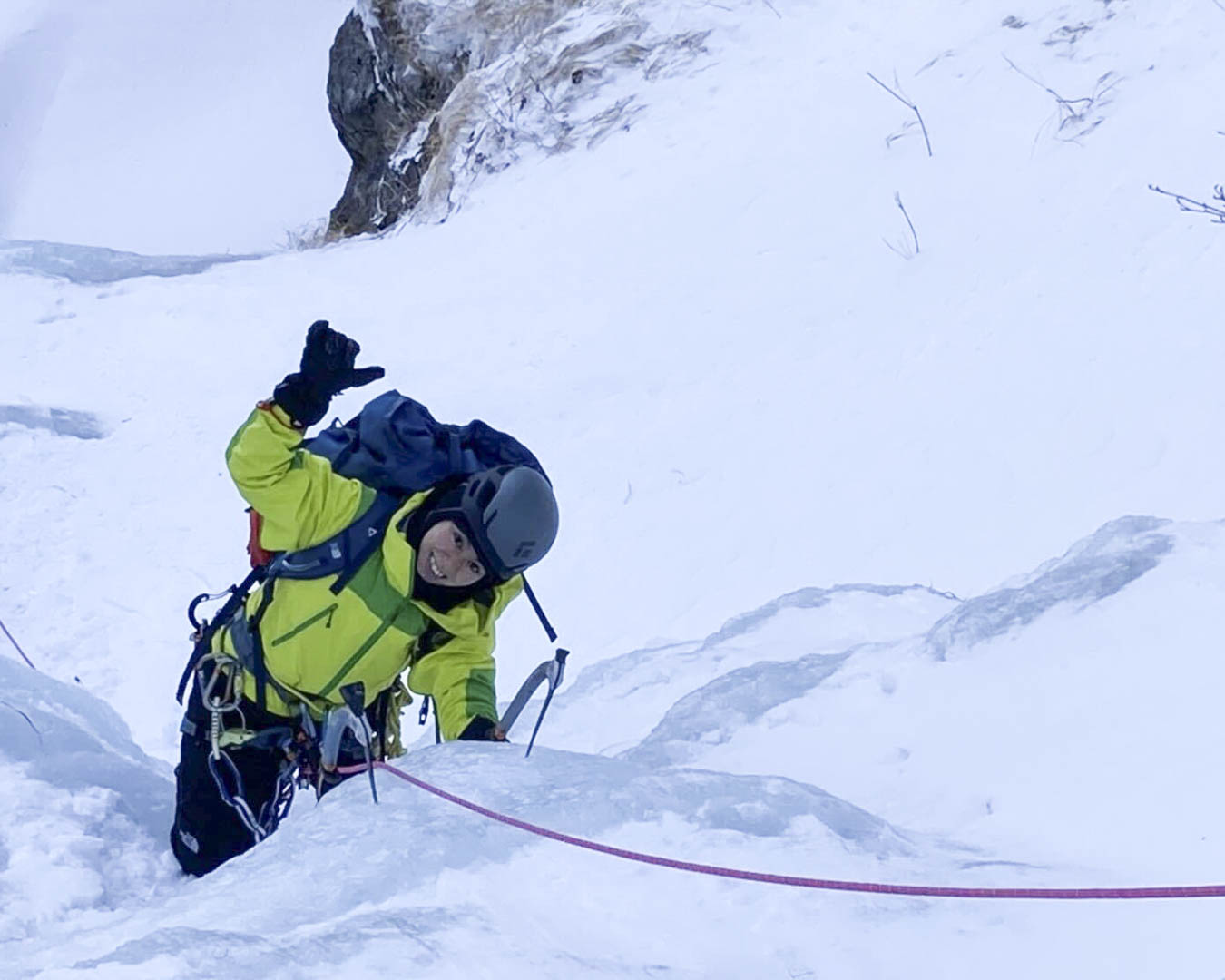

Q: What kind of activities are you into now?
AU: In the summer, I enjoy canyoning, alpine climbing or rock climbing. I also started tenkara fishing (traditional fly fishing) along with canyoning last year. In winter, I go for long-distance traverses or day trips, and I also enjoy alpine and ice climbing.
Q: That’s pretty hardcore.
AU: No, I just do everything casually.
Q: Can you tell us about your favorite mountain gear?
AU: Sure. Let’s start with the Aluminum Hoshimaru Cup L from Daiichi Aluminum Manufacturing.
1. Daiichi Aluminum Manufacturing Aluminum Hoshimaru Cup L
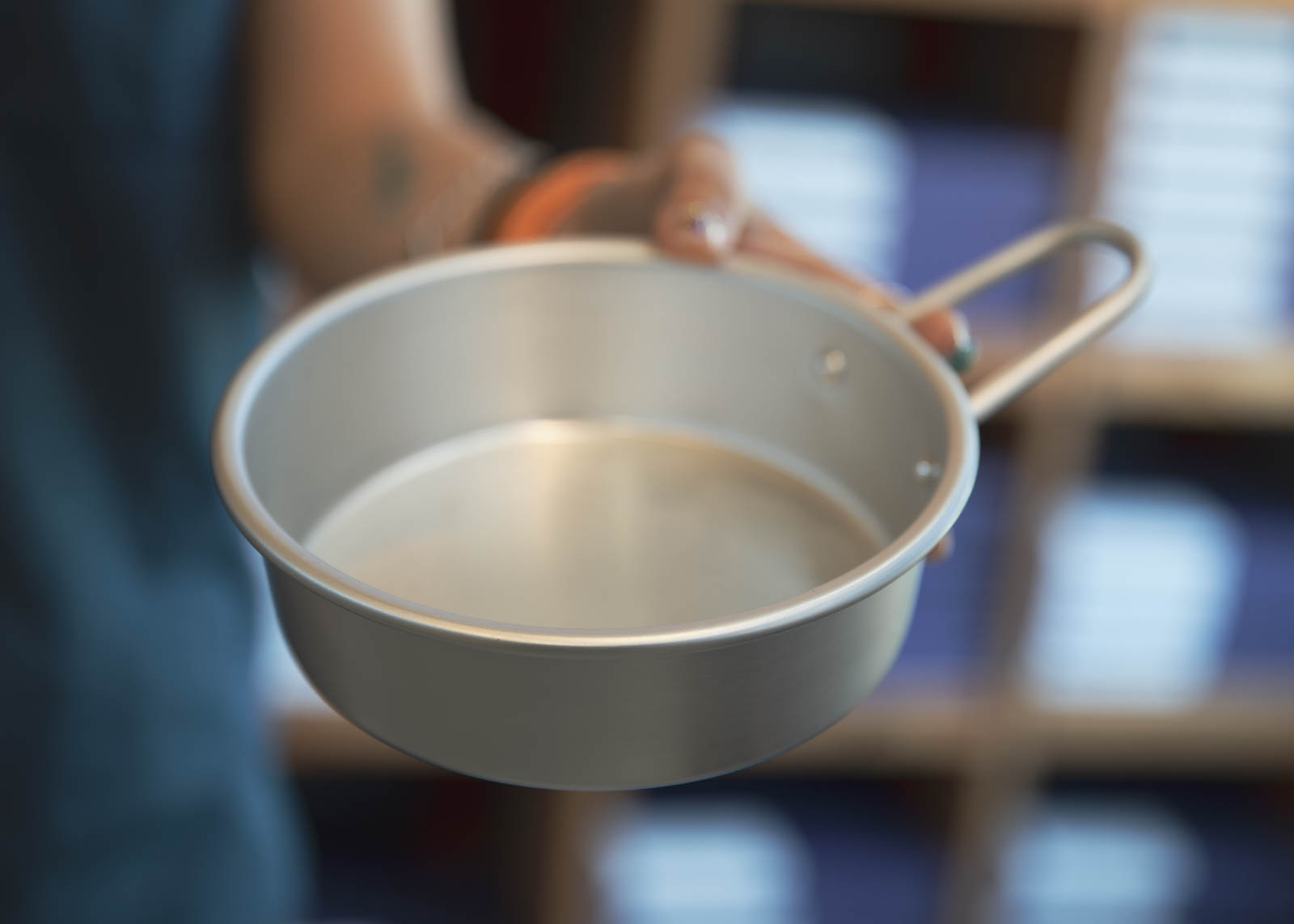
Q: Is this a Japanese product?
AU: Yes, it’s made by a company that usually manufactures aluminum lunchboxes. They recently released this cup, and when I saw it, I thought it would be perfect for solo hot pots or udon in the winter. It’s quite light at 86 g, and since it’s made of aluminum, it’s really convenient.
Q: It looks good for ramen, too.
AU: Exactly, it’s just the right size. And because it’s aluminum, you can put it directly into a campfire. I only bought it recently, but I’ve already used it a lot this year.
Q: What have you made with it?
AU: I recently made nabeyaki-udon (noodle hotpot) with it. I put in a bit too many ingredients, so some of the broth spilled out. I’m not a big fan of eating freeze-dried food or instant rice. I love eating, and I often take along udon or soba. This cup is one of my favorites because it’s perfect for making single servings. But I haven’t found a lid that fits yet. It would be great if I could find one.
Q: There should be something available. It says it’s 16 cm in diameter. You might find a matching lid if you look around.
2. Atelier Setsugekka’s TriPod Ti Power

Q: What’s next?
AU: Next is the TriPod Ti Power by Atelier Setsugekka.
Q: This is a trivet for solid fuel stoves, right?
AU: Yes, it is. When I saw this, I thought the design was beautiful. I’ve always liked alcohol stoves and owned various kinds, but after finding this, I started using solid fuel. It looks nice, and because it’s so light, it helps to reduce the weight of my gear.
Q: And for the solid fuel stove or base, you use a can lid?
AU: Exactly. I often use FireDragon solid fuel, but it leaves a lot of white residue after burning. With this setup, you can just dispose of the residue easily.

Q: So you keep these when you have canned drinks?
AU: Yes, I stockpile them.
3. Staticbloom Yak Leg Warmer
AU: The third item: Staticbloom Yak Leg Warmers.

Q: Do you wear these while you’re on the move?
AU: I mainly wear them when I’m inside the tent or sleeping. I can’t sleep if my feet are cold. With these warming my calves, I can feel the warmth spread from my feet to the rest of my body.
Q: You could wear warm socks, too, but you prefer these?
AU: In addition to warm socks, not instead of.
AU: The third item: Staticbloom Yak Leg Warmers.

Q: I see. You wear warm socks but you also want to keep your calves warm.
AU: Exactly. These are made of yak wool, so they are soft and warm.
Q: That’s a great tip from someone who gets cold easily!
4. Finetrack Polygon 2 Blanket

Q: What’s next?
AU: The Finetrack Polygon 2 Blanket. This item has been discontinued since I bought it.
Q: Is this long enough to cover your entire body?
AU: It’s 140 cm by 85 cm, so it doesn’t wrap around completely, but I use it as a sleeping bag in the hot summer. It weighs 250 g, and it’s made of a synthetic non-woven fabric, known as Polygon, which is very practical since it performs even if it gets wet.
Q: I’ve heard that Polygon can be a bit crinkly. Is that true?
AU: It’s not that noticeable. This one also has buttons, so you can wrap it around like a poncho or use it as a skirt. It’s very versatile for when you’re wearing a down jacket but need something for your lower body.
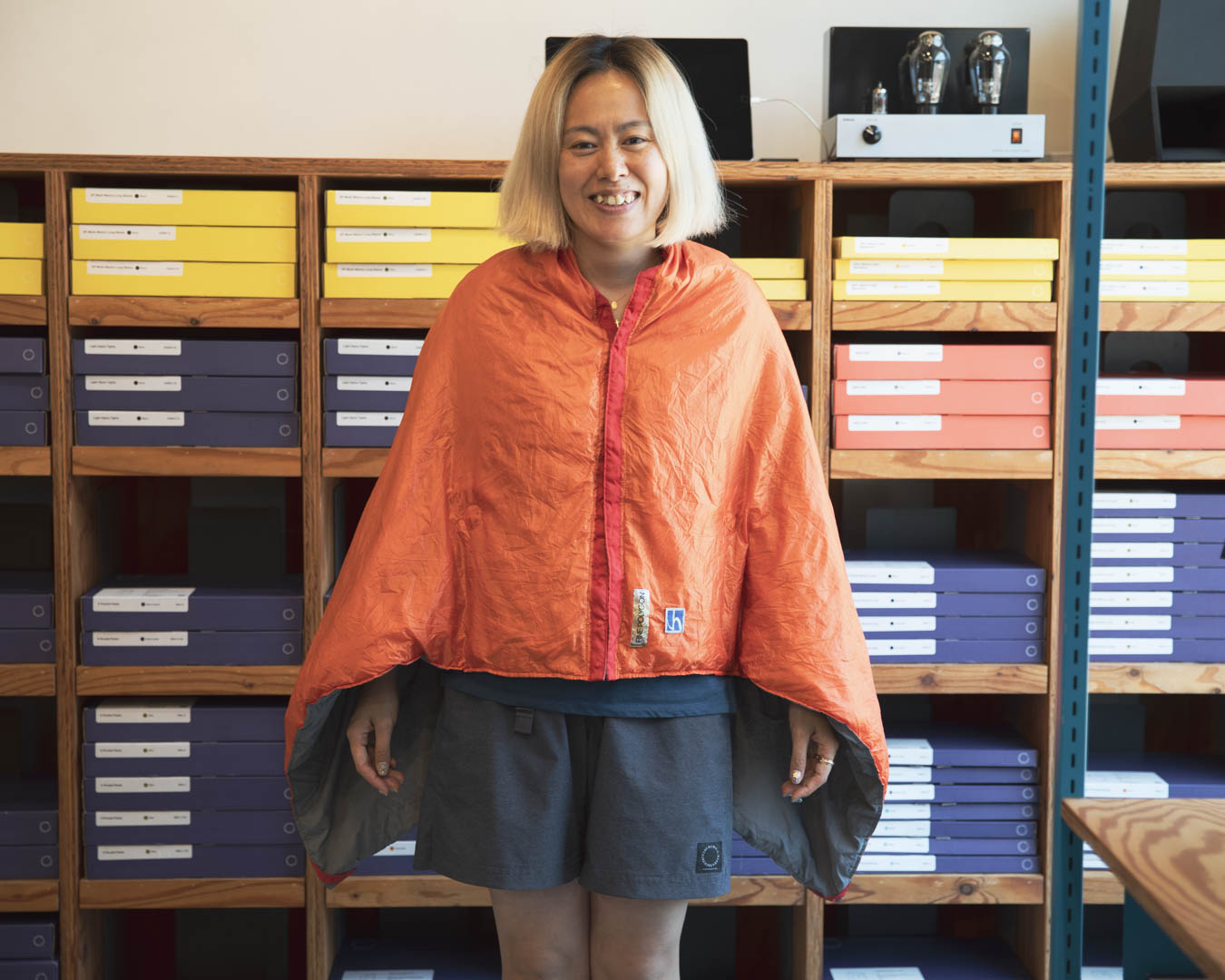
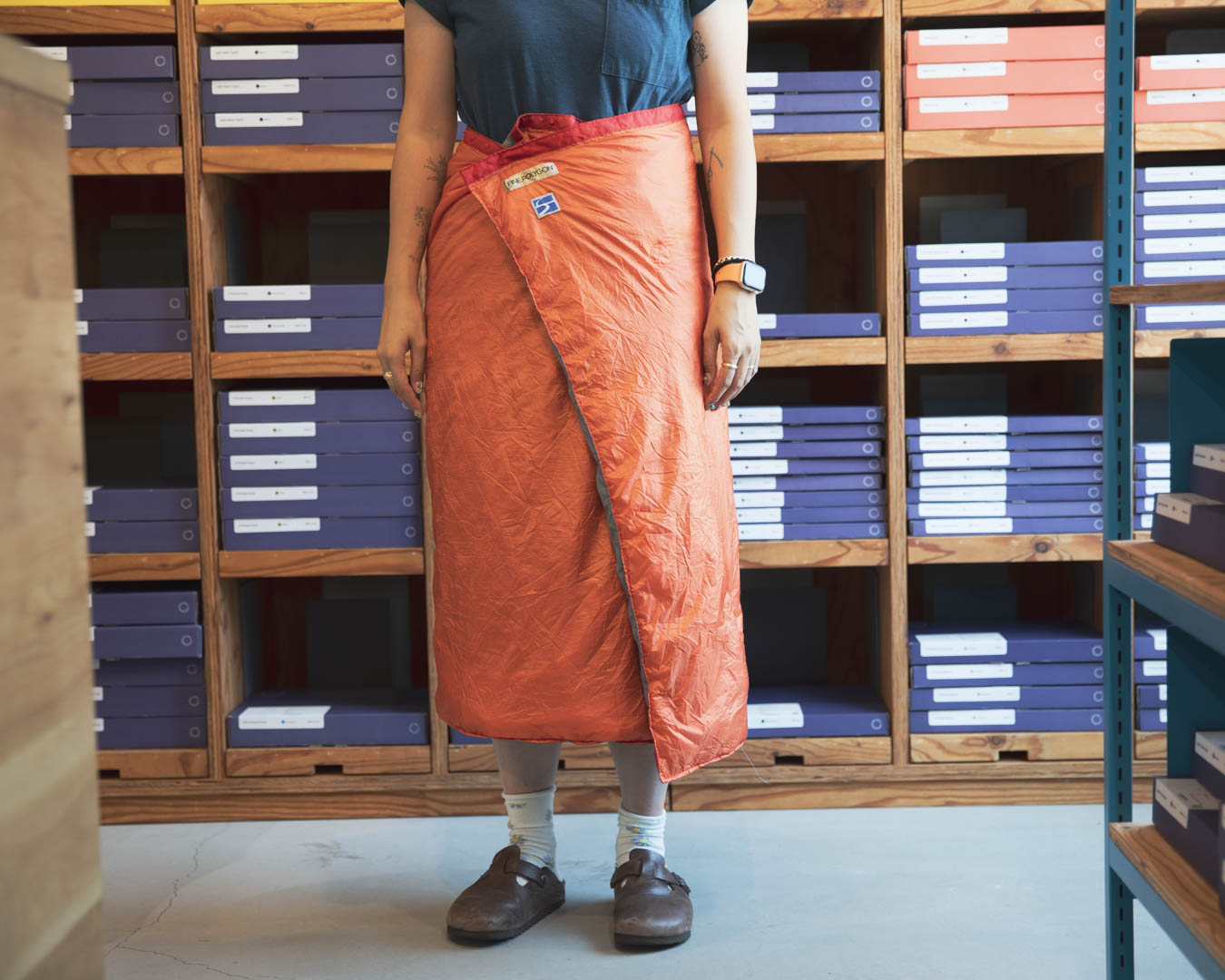
Q: Because it’s made of a synthetic material, you can handle it roughly, right?
AU: Exactly. I prefer insulation that uses synthetic filling, so whenever I see something like this, I want it. Also, I like it because I can treat it roughly. Because I’m prone to feeling cold, I use it as added insulation for my sleeping bag in October and November, or instead of a down jacket.
Q: It’s a shame that it’s no longer available.
5. Patagonia Houdini Pants
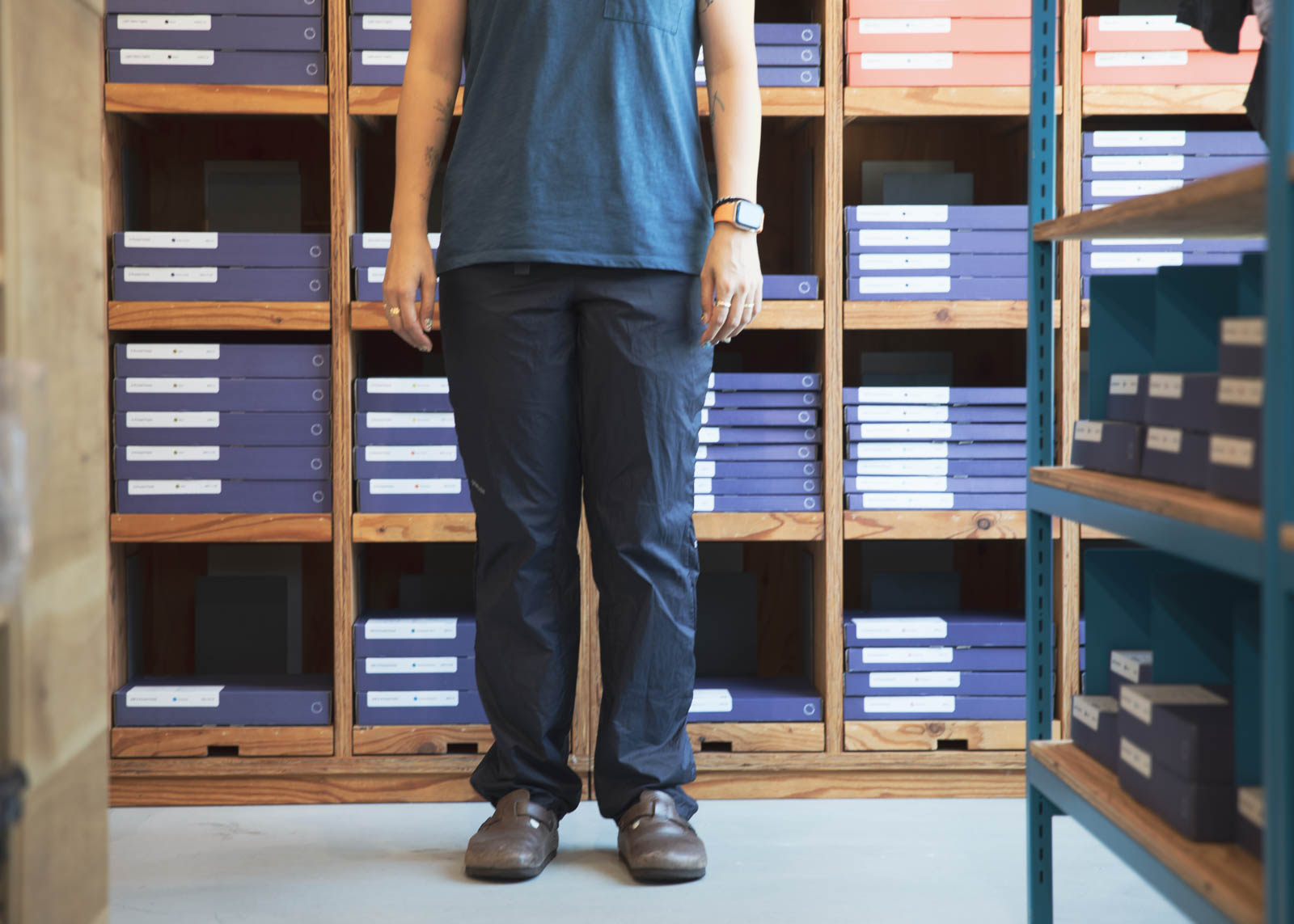
AU: The next item is also something that’s no longer available: Patagonia’s Houdini Pants.
Q: Oh, these.
AU: There are a lot of mosquitos in summer in low-altitude mountains here. Regular pants are too hot, but I’m fine with these Patagonia pants because they’re thin. Even if they’re damp with morning dew, they dry quickly. They’re very compact and lightweight. I’ve been using them for a long time.

Q: The Patagonia Houdini Jacket is famous, but the pants are a little-known gem. A lot of people seemed to like them. You can wear shorts and bring just these as your long pants.
AU: You can do that. In a light shower, you can wear a rain jacket on top and these pants on the bottom, and you’ll be fine.
Q: Yamatomichi’s UL All-weather Pants are designed to be used in a similar way?
AU: My body temperature runs hot, and I sweat a lot, so the UL All-weather Pants aren’t comfortable for me. These Houdini Pants are not waterproof, but they work better for me.
Q: It would be nice if there were more pants like these.
6. Enlightened Equipment Revolt V2 Custom Underquilt

Q: What’s next?
AU: I’ve mostly shown items that are unavailable or that I’ve used for a long time. For the last product, I’ll talk about something that I recently bought: the down-filled Enlightened Equipment Revolt V2 Custom Underquilt.
Q: You can customize the fabric and down amount for this, right?
AU: That’s right. My old fall-winter sleeping bag was quite heavy, so I got this one with 950 fill-power down and extra filling so it’s usable even in winter. It can handle temperatures down to around minus 6 degrees C.
Q: How many grams of down does it have?
AU: 378 g. Its total weight is just under 600 g, so it’s both warm and light. I also recently bought a hammock. The Revolt V2 can be used with a hammock.
Q: This quilt opens up completely in the back, so when you sleep in a hammock, you can wrap it around the entire hammock, right?
AU: Exactly. And if it’s too warm, I can use it as a blanket.

Q: How much does this weigh?
AU: It’s about 527 g. I customized it to be on the warm side.
Q: 527 g but also good to minus 6 degrees C –– that’s impressive.
AU: You can choose the colors, too. It’s not very bulky and it’s pretty warm. If I can’t handle the cold with this, then it might be time for me to buy something specific for winter.

Q: In the winter, you could combine it with a summer down bag, too. Can you order thinner versions of this?
AU: You can. You get to choose the amount of down and the thickness of the fabric.
Q: So, you chose a pretty thin one?
AU: I chose a 7-denier (weight of the fabric) lining, and 10-denier outer fabric, if I remember correctly. I considered 7 denier for both, but I’m a bit rough with my gear so, to avoid holes, I opted for a slightly thicker outer fabric. I haven’t tried it with the hammock yet, so I’m looking forward to that.
Q: Keep hitting the trails and let us know how it goes!
Stephen Moss’s Recommended Gear

Stephen Moss is a staffer at Yamatomichi Zaimokuza’s store. Born and raised in coastal Zushi, Kanagawa prefecture, Moss –– who is half-American (his father is ex-US military) –– graduated from Aoyama Gakuin University’s Faculty of Literature. Passionate about skateboarding from a young age, he appeared in the movie “Haru no Ensoku Skateboard de” (Spring Excursion: Skateboard Adventure). He learned about the US Pacific Crest Trail and became fascinated with thru-hiking. His wanting to carry a locally made backpack –– Yamatomichi –– on US long trails led him to ultralight hiking. At Yamatomichi, he handles English-language customer support and product page translations, and is exploring ways to combine skateboarding and ultralight hiking.
From Skater to PCT Thru-Hiker
Q: Let’s start with a brief self-introduction.
SM: My name is Stephen Moss. I was born and raised in Zushi, a coastal city in Kanagawa prefecture. While attending university, I began searching for a job and came across a posting at Yamatomichi. I applied and ended up here.
Q: You’re Yamatomichi’s first newly graduated hire?
SM: Co-founder Akira Natsume never dreamed of hiring someone straight out of university.
Q: You’re a skater, right?
SM: I grew up skateboarding in Zushi. While at university, I dreamed of walking the Pacific Crest Trail –– the PCT is one of three major US long trails –– and I got really into hiking. I discovered Yamatomichi and dreamed of thru-hiking the PCT carrying a Japanese backpack. Then I joined the company, and last year, I completed the PCT.
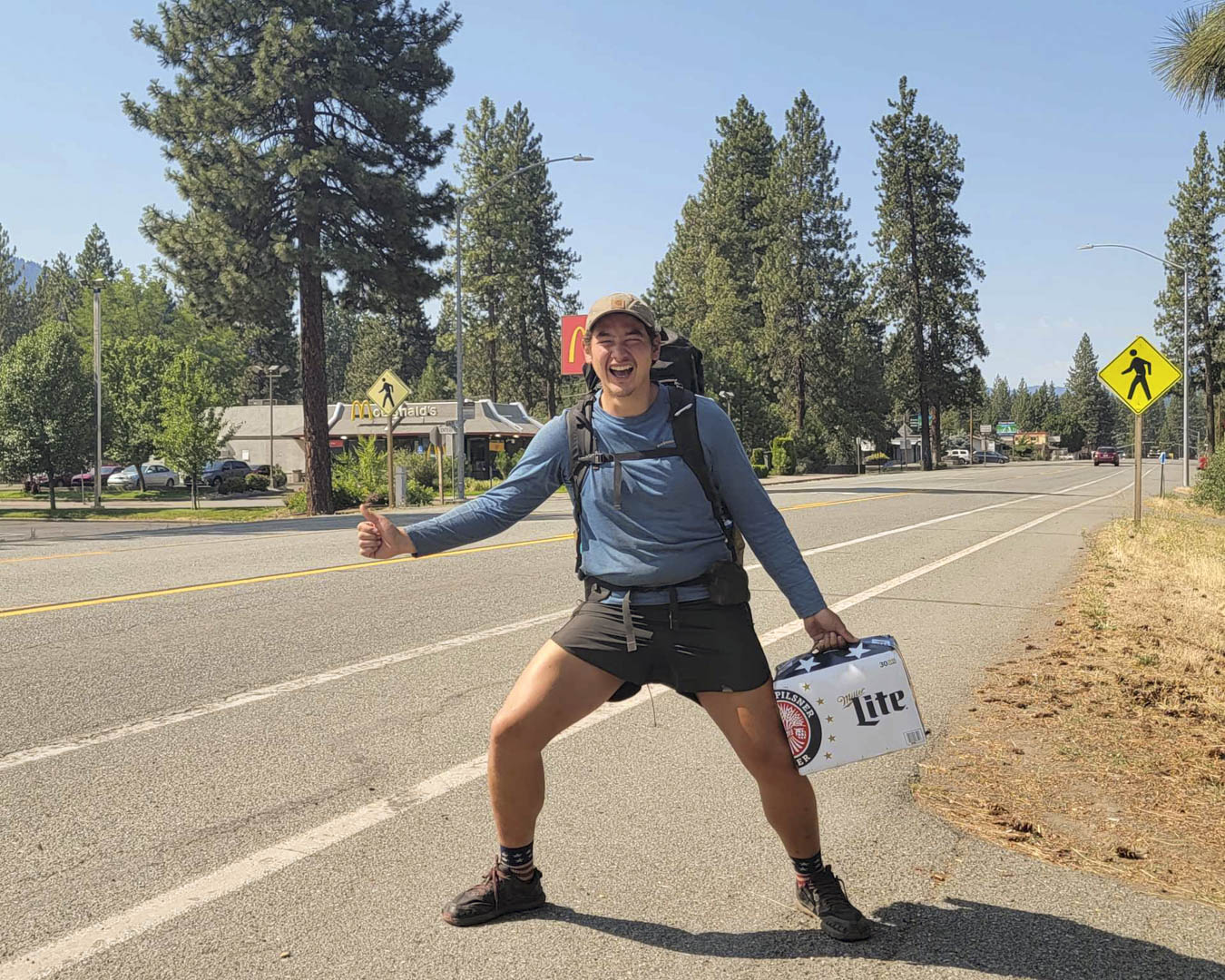
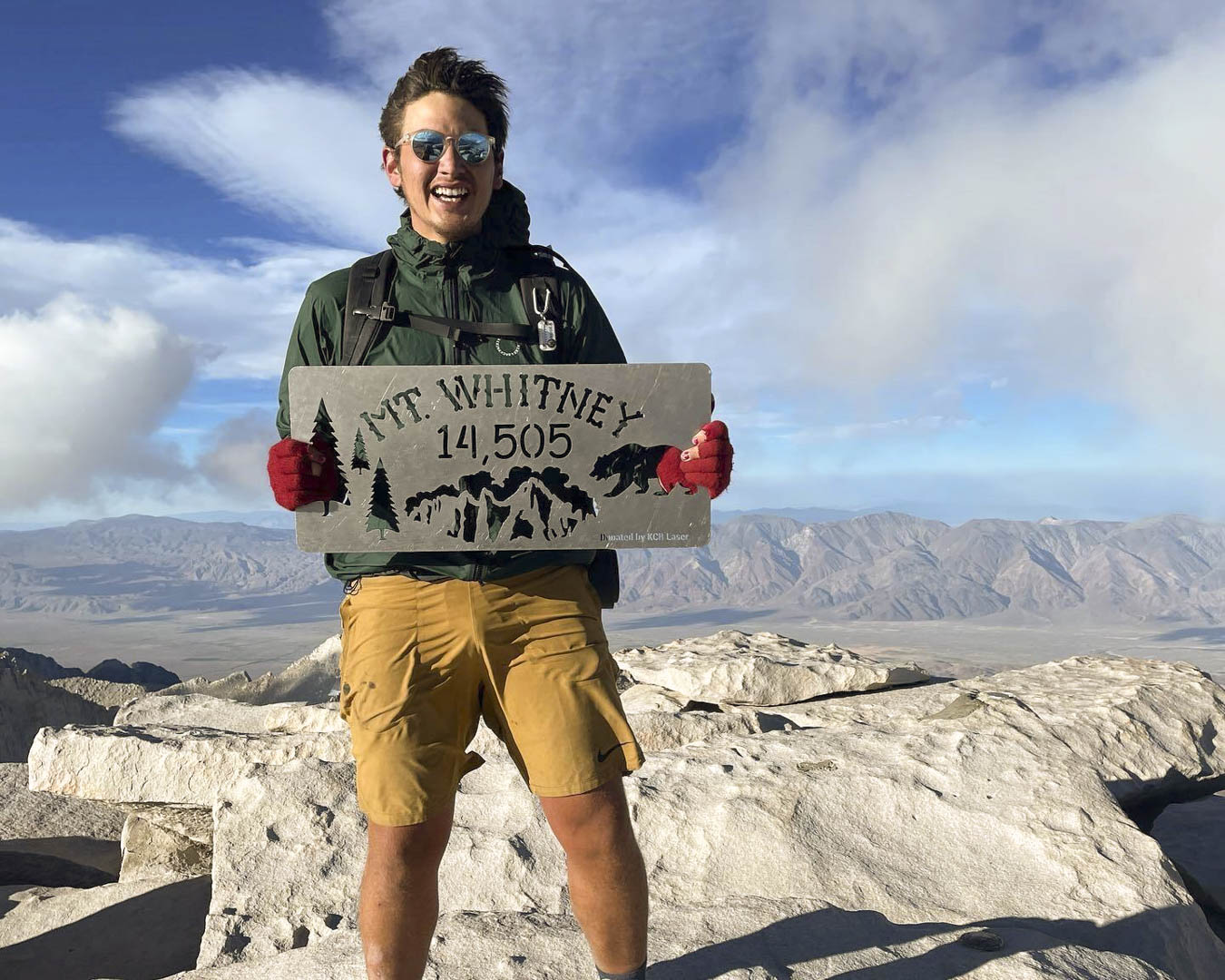
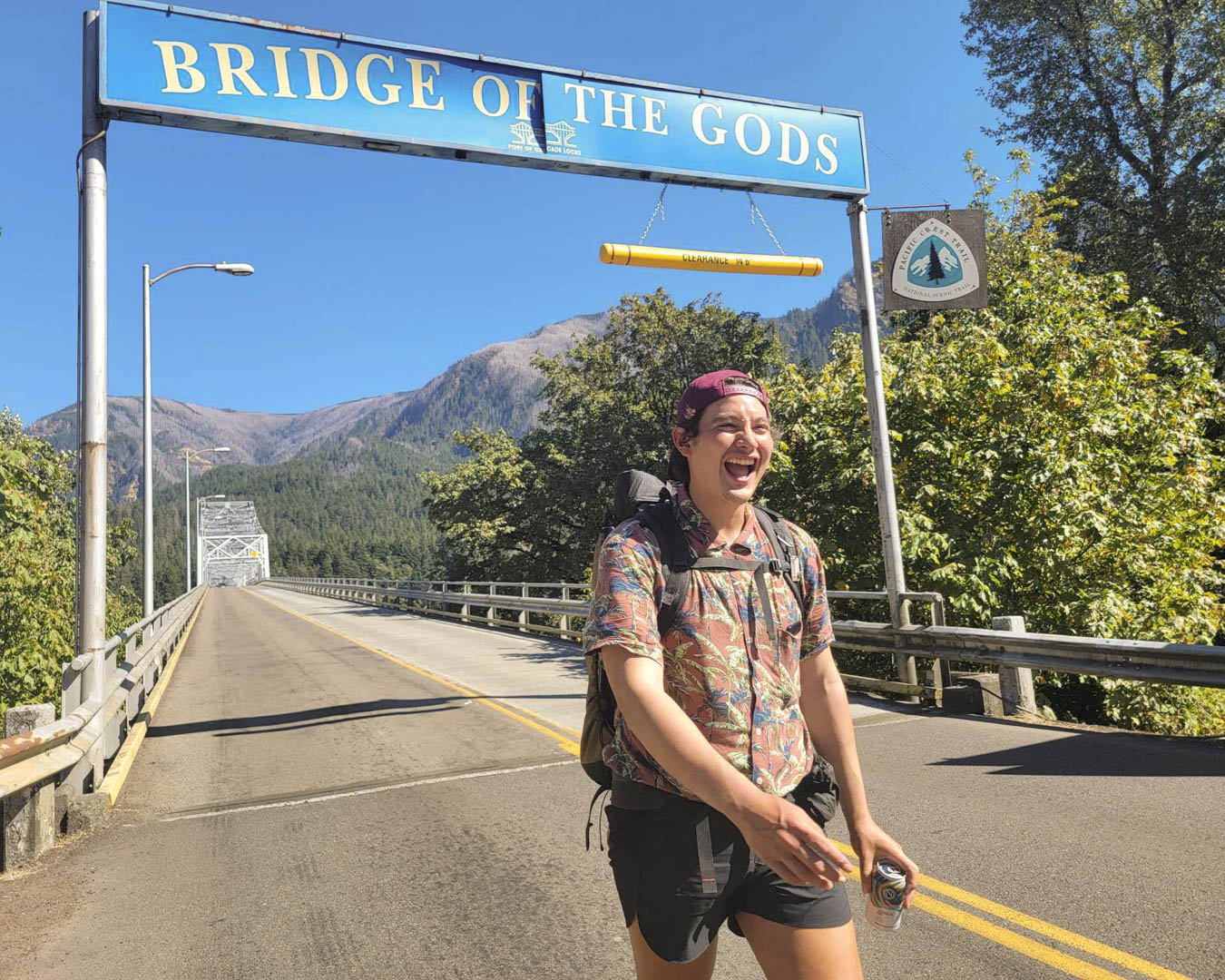
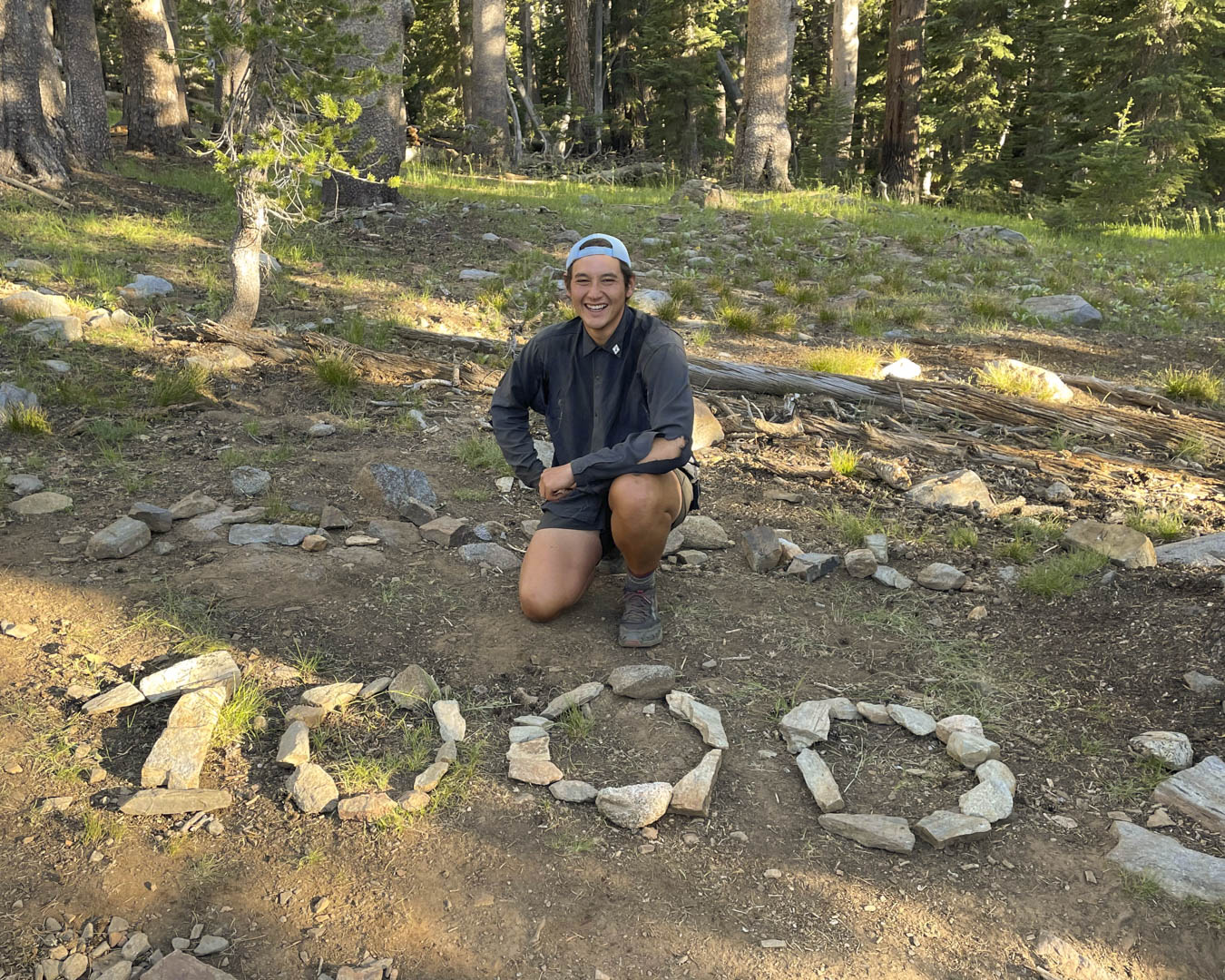
Q: You worked for a year before heading to the PCT.
SM: After working for a year, Yamatomichi gave me time off to walk the PCT. I became a thru-hiker and I came back as the real deal.
Q: A real hiker.
SM: Exactly!
Q: And now you’re back at Yamatomichi.
SM: I work at the Zaimokuza store, in Kamakura, translating Yamatomichi Journals and product pages, and handling customer service in English.
Q: Is hiking your main outdoor activity now?
SM: I prefer thru-hiking more than just regular hiking. I don’t do short trips much. I feel more motivated to go out on trips that are at least five days long.
Q: After walking for half a year, that makes sense.
1. Zpacks Large Food Bag
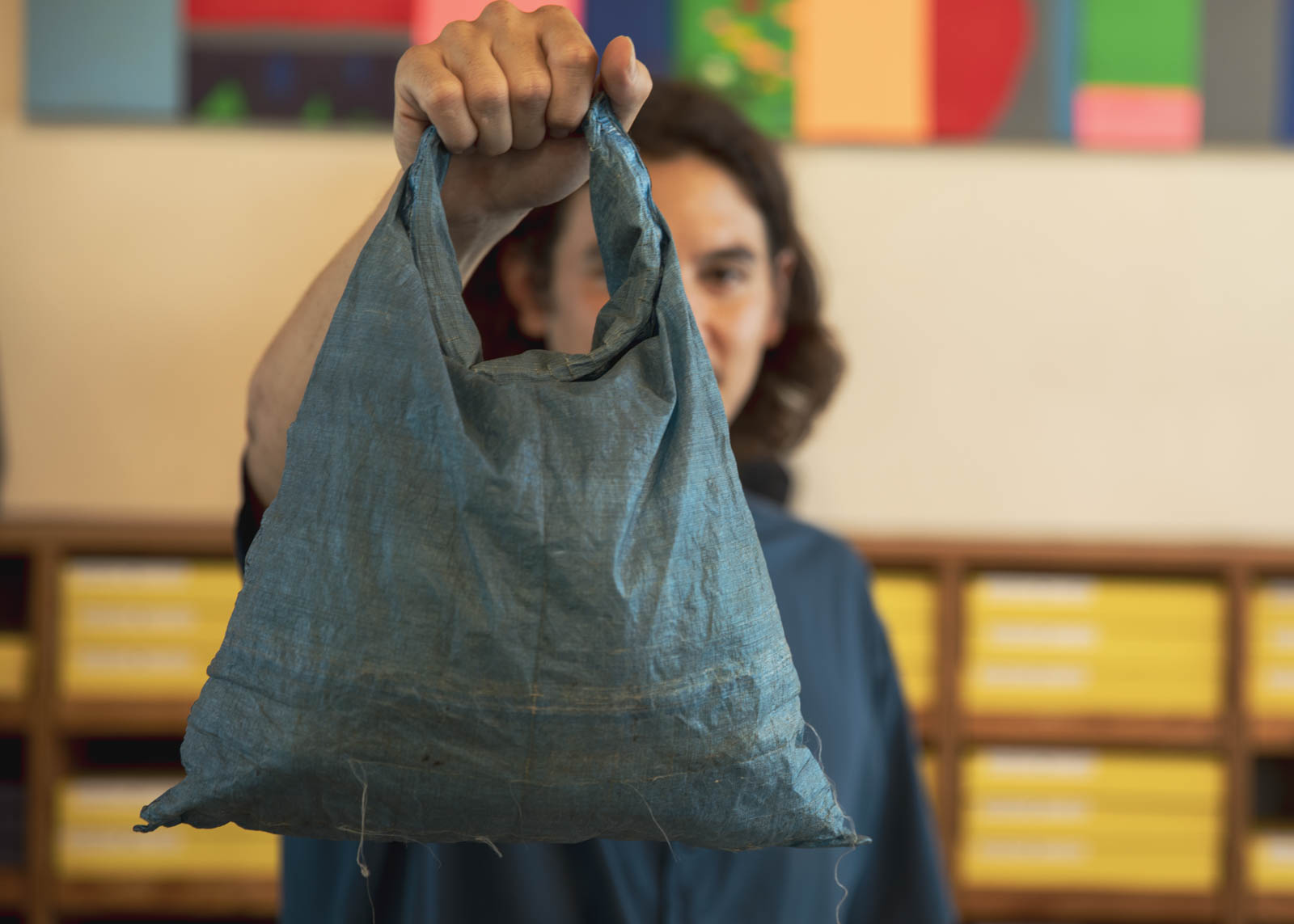
Q: Could you tell us about your favorite outdoor gear? These are mostly things you used on the PCT?
SM: Mostly, yes. The first item is Zpacks’ Large Food Bag, which I got as a gift. About halfway through the PCT, a friend whom I had been hiking with gave me his old one after he bought a new one.
Q: I use the same bag. But yours is so worn out it looks like a different product.
SM: My friend thru-hiked the Appalachian Trail –– the AT is one of the three major US long trails –– with this bag, then passed it on to me. I completed the PCT with it, so this bag has more miles on it than I’ve hiked. If I take it on the Continental Divide Trail –– the CDT is one of the three major US long trails –– it will have been on all of the major US long trails even before me.
Q: Recently, a fox bit into mine and punctured it while I was hiking in Shiretoko, Hokkaido. But seeing yours makes me feel like I need to keep using mine for much longer.
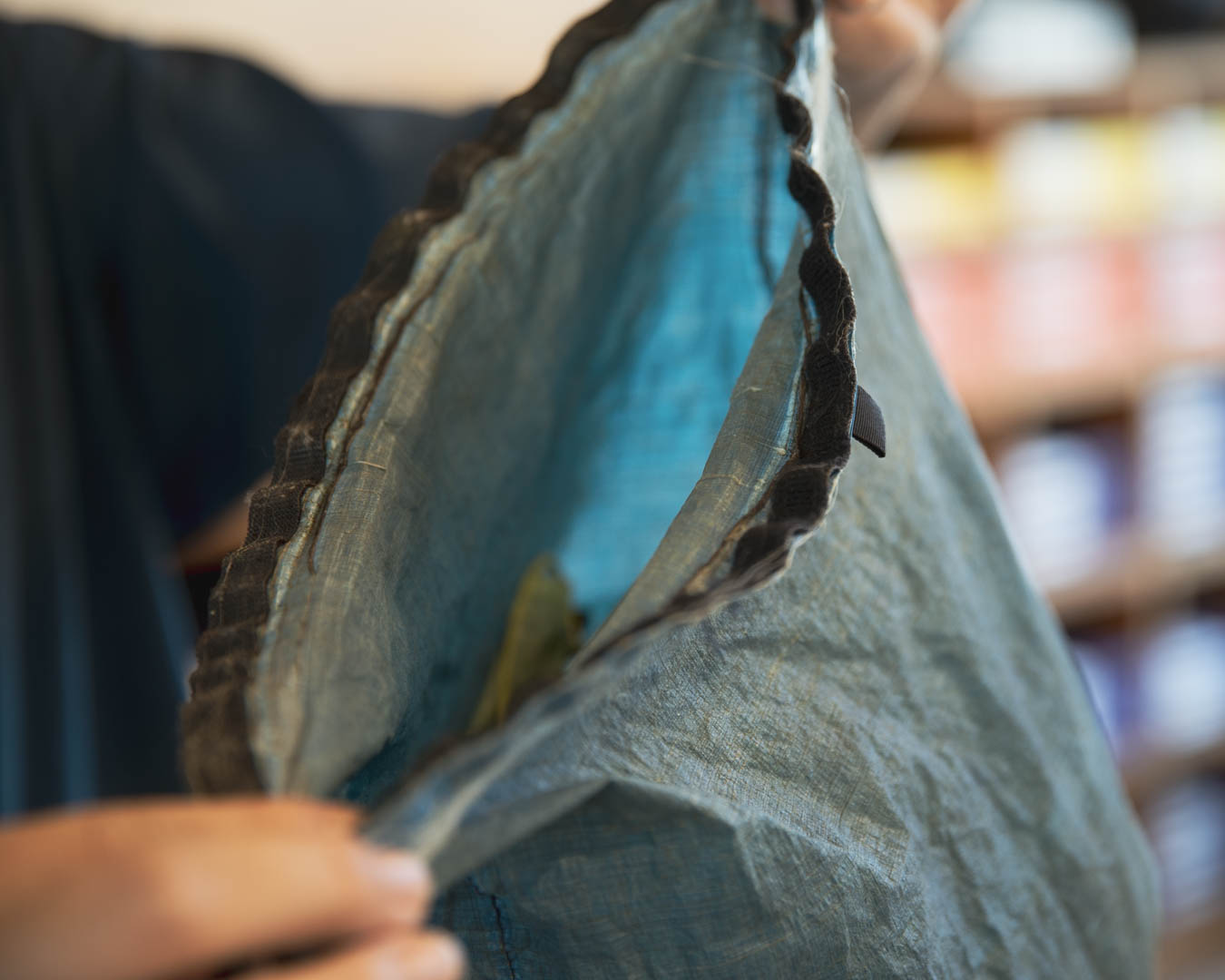
SM: It’s still holding up! It’s barely functioning as a bag, but I love how worn out it looks. When I think about how it’s there waiting for me, I can’t imagine throwing it away, and I can’t think about buying a new one. It’s a bit too big for a one- or two-night trip, though.
Q: That’s why I use mine to hold food, my stove, and all my batteries. It’s convenient to just search through this bag instead of emptying out my whole pack to find what I need.
SM: Exactly, I do that, too.
Q: My sleeping bag stuff sack is at the bottom, the one with my clothes is in the middle, and this one’s on top. It’s hard to find a stuff sack this size anywhere else.
SM: I don’t like dividing things up, so this is the only stuff sack I carry. My sleeping bag and clothes are at the bottom of my pack, and besides those things it’s just this.
Q: I won’t be replacing mine for a long time, either.
2. Patagonia Micro Puff Jacket
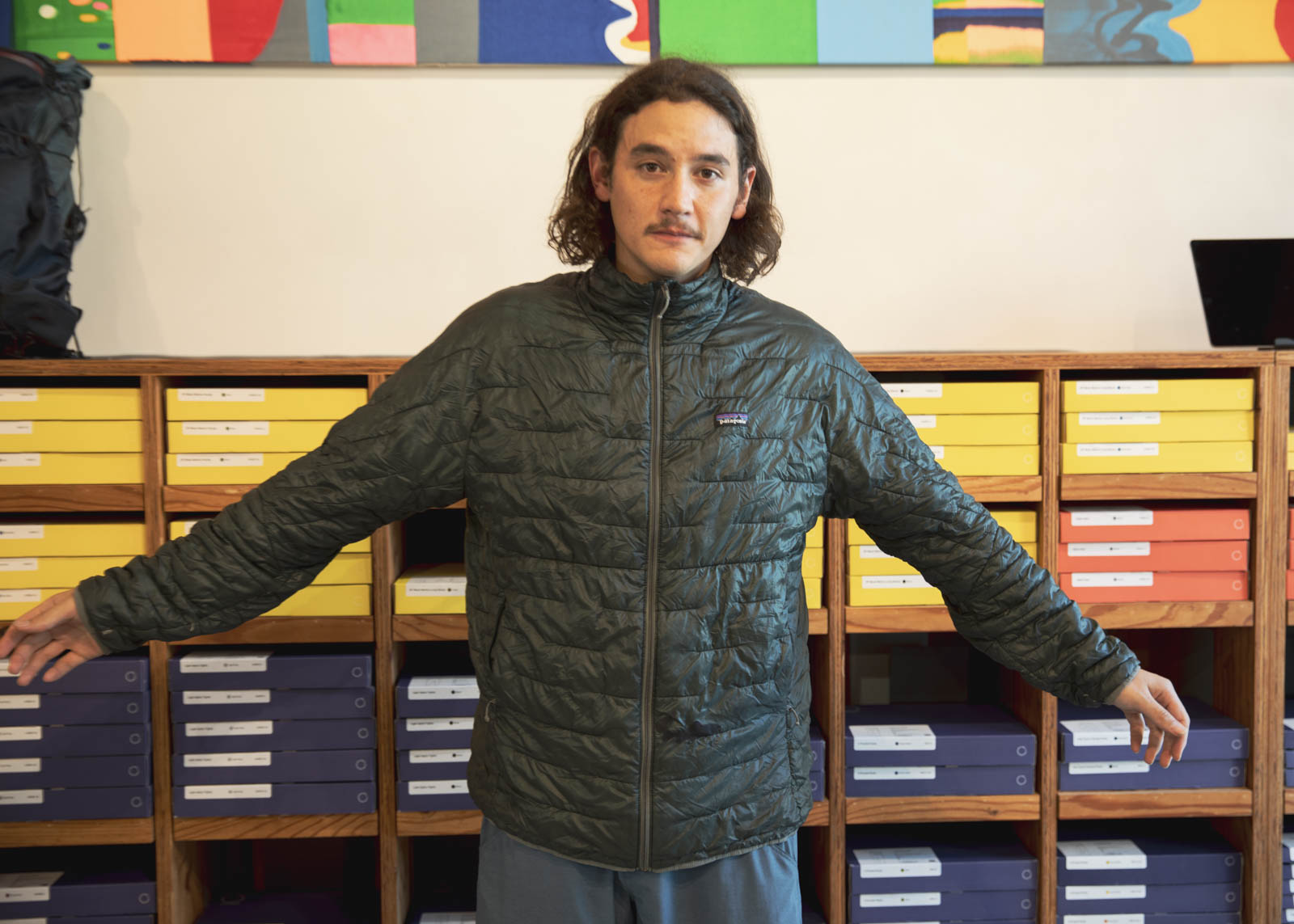
Q: What’s next?
SM: The item that I used the most and that lasted the longest on the PCT was my Patagonia Micro Puff Jacket. This is something I owned even before joining Yamatomichi. It’s the first piece of gear I ever bought. I read a lot about the PCT and this was the jacket mentioned the most, so I bought it without too much thought.
Q: The Micro Puff is almost like a uniform on the PCT, right?
SM: There were a lot of them on the PCT.
Q: On long trails, synthetic insulation is often preferred over down.
SM: It’s probably well-known because it’s the most expensive Patagonia jacket. My body temperature is on the high side, so I didn’t need a mid-layer. Even in quite cold weather, I’d just wear the UL Rain Jacket over my t-shirt. When it was around 5 degrees C, I’d hike in short sleeves. I never wore my Micro Puff while hiking. I’d keep it at the top of my pack and, if the temperature was between 5 degrees and 10 degrees C, I’d quickly put it on when I stopped.
Q: Just throw this on over a t-shirt…
SM: Exactly. I’d mainly hike in a T-shirt and then put on the Micro Puff when I stopped. Also when sleeping. My sleeping bag, which I’ll be talking about later, doesn’t have much down filling, so I’d usually wear the Micro Puff to bed. By nightfall, my pack would be almost empty. When it was time to sleep, I was using everything I had.

Q: It sounds like you’re not carrying any gear that you don’t need.
SM: Putting the jacket in the dryer doesn’t damage it at all. When you reach a nearby town while on the PCT, I’d just throw it in the washer and dryer. Having that peace of mind is perfect for a long trail hike.
Q: It’s a classic.
SM: A classic.
3. Katadyn BeFree and Hydrapak SkyFlask Speed 500
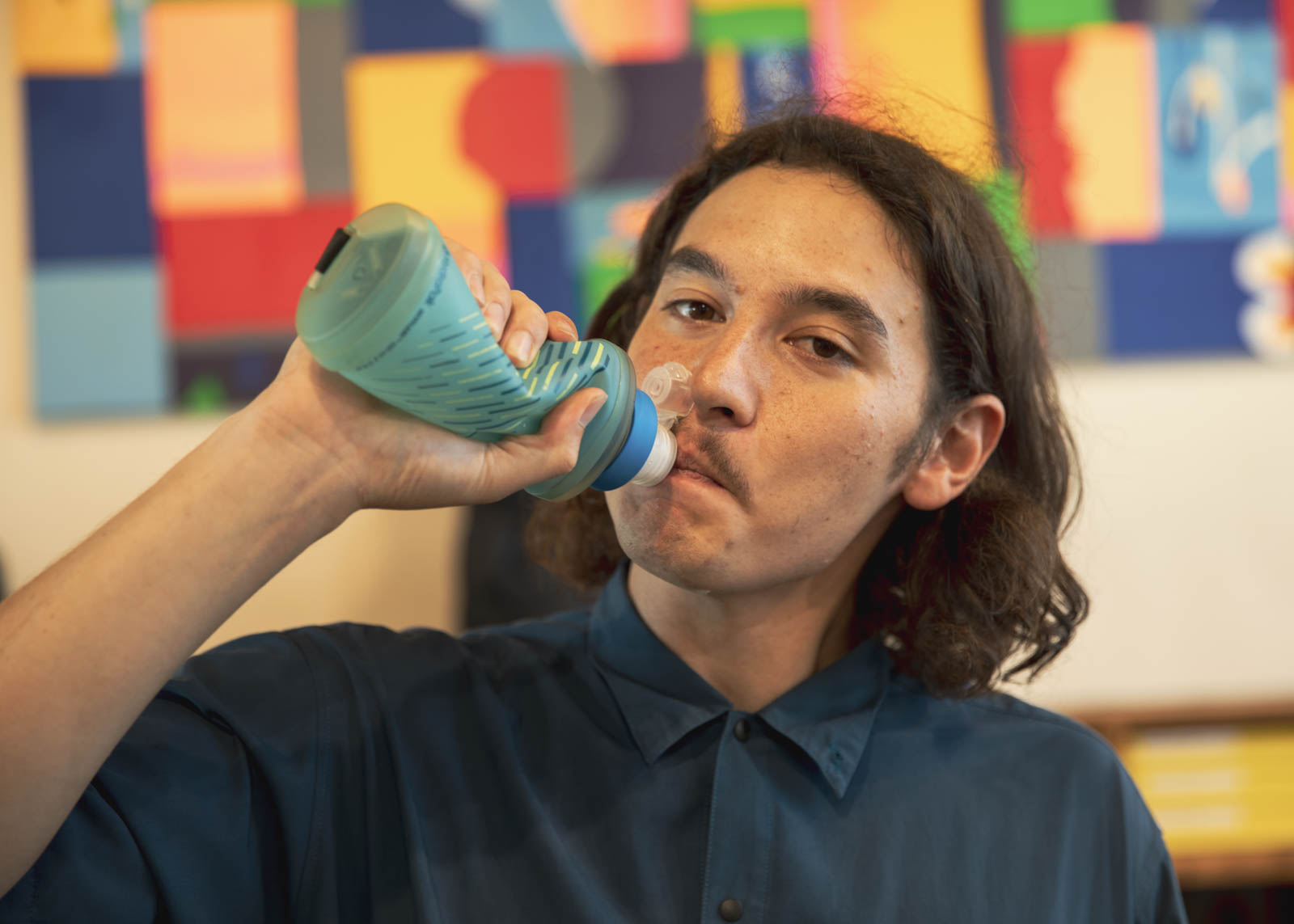
SM: Next up is the bottle setup I used on the PCT: the Katadyn BeFree 1 L water filtration system and Hydrapak SkyFlask Speed 500.
Q: The BeFree filter combined with the soft flask.
SM: Exactly. I started off with the BeFree, but the 700 ml bottle that it came with tore. So I switched to the HydraPak.
Q: You probably wouldn’t have made the change if the bottle hadn’t torn.
SM: I tried taping it up, but it burst the day before I reached a town along the trail. Fortunately, I had sent a resupply box to the town and it included the HydraPak. It turned out to be a great purchase. The HydraPak is really strong. I walked with it for about half of the PCT and treated it quite roughly, but it didn’t tear.
Q: This is the one that comes with a handle?
SM: Yes. It was sold in a pack of two 500 ml bottles. At some point along the trail, I realized that I preferred holding the bottles while walking. When you’re carrying food for five days, the water makes the backpack heavy. Lightweight freeze-dried food is expensive, so instead I often carried heavier, cheaper options. Carrying a water bottle in each hand helped lighten the weight in my pack.
Q: You carry two of these?
SM: Yes. Holding them during descents felt good –– they would swing back and forth like pendulums.
Q: When you’re not holding anything, do your hands feel idle? As if you don’t know what to do with them?
SM: Definitely, especially when you’re used to holding trekking poles all the time.
Q: It’s hard to figure out what to do with your hands. Having something to hold helps, I guess.
SM: Sure, though I’ve grown tired of carrying two bottles. Lately, I’ve been walking with just one
bottle. I don’t like carrying water on climbs, so while I’m walking my bottle is usually empty. When I reach a stream, I fill the HydraPak, drink it all at once, and then wait to drink again until I reach the next stream. That way I can walk without lugging around water. It’s no hassle filling the water, either.
Q: It helps that the BeFree filter has a fast flow rate.
SM: It’s fast. Not having to take off the backpack to fill and purify water is very convenient, too.
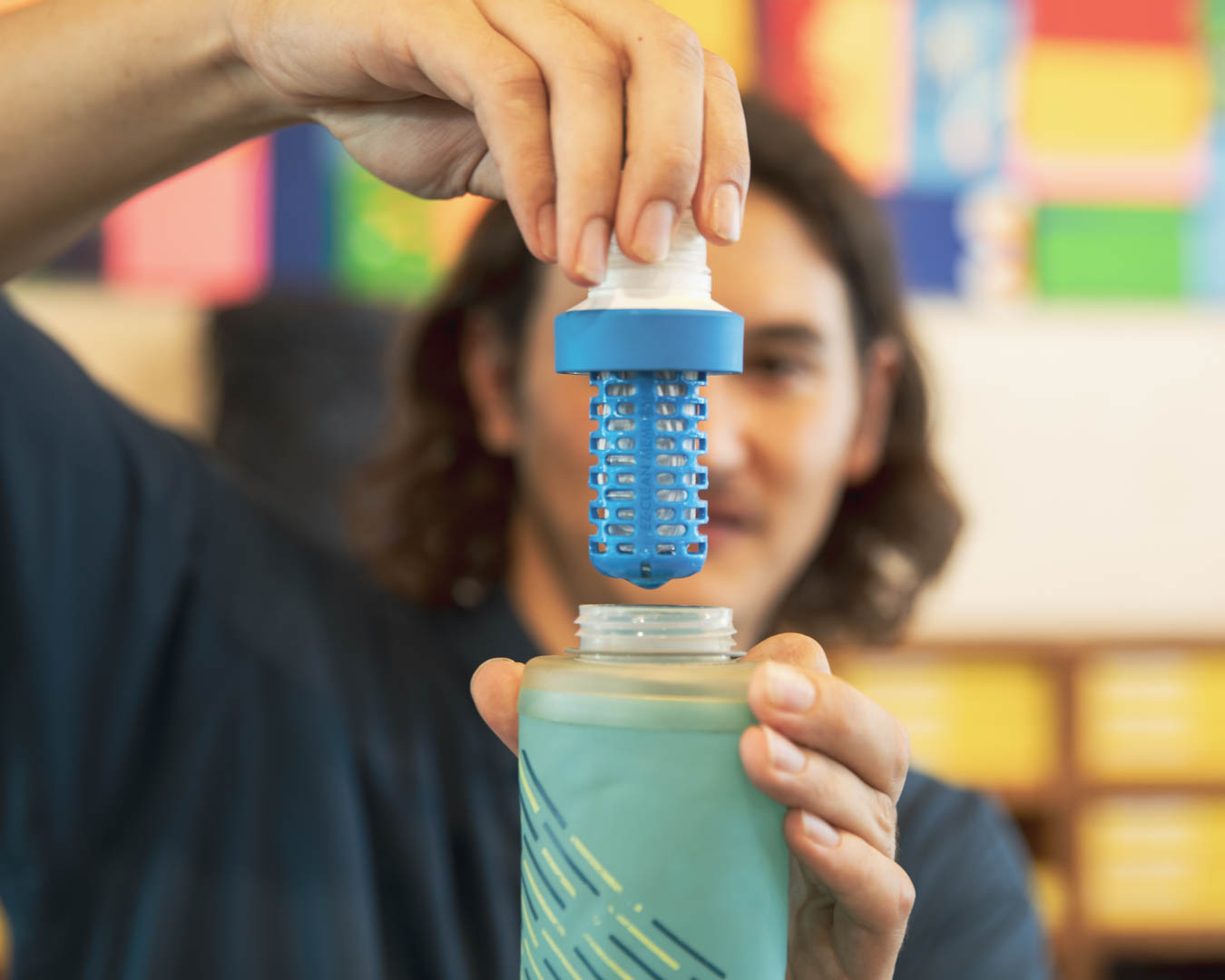
Q: With the BeFree attached to its original bottle, it doesn’t feel like you’re holding it all the time. The 700ml size makes it kind of floppy.
SM: Exactly. It gets a bit floppy.
Q: This one is just the right size.
SM: The end is a hard plastic, so it can stand on its own.
Q: The BeFree bottle doesn’t do that.
SM: Also, the opening is large, so filling 500 ml only takes a moment. Literally, 5 seconds, sometimes only 3 seconds. Along sections where water is scarce or where the streams flow slowly, you can just set this down. You can have a cigarette while you’re waiting.
Q: That’s really convenient.
SM: When you’re walking 50 km a day, you don’t really have time to stop. Stopping is a nuisance. Which is why I like this setup. I suspect I’ll stick with this for the rest of my life.
4. Enlightened Equipment Revelation Custom Sleeping Quilt
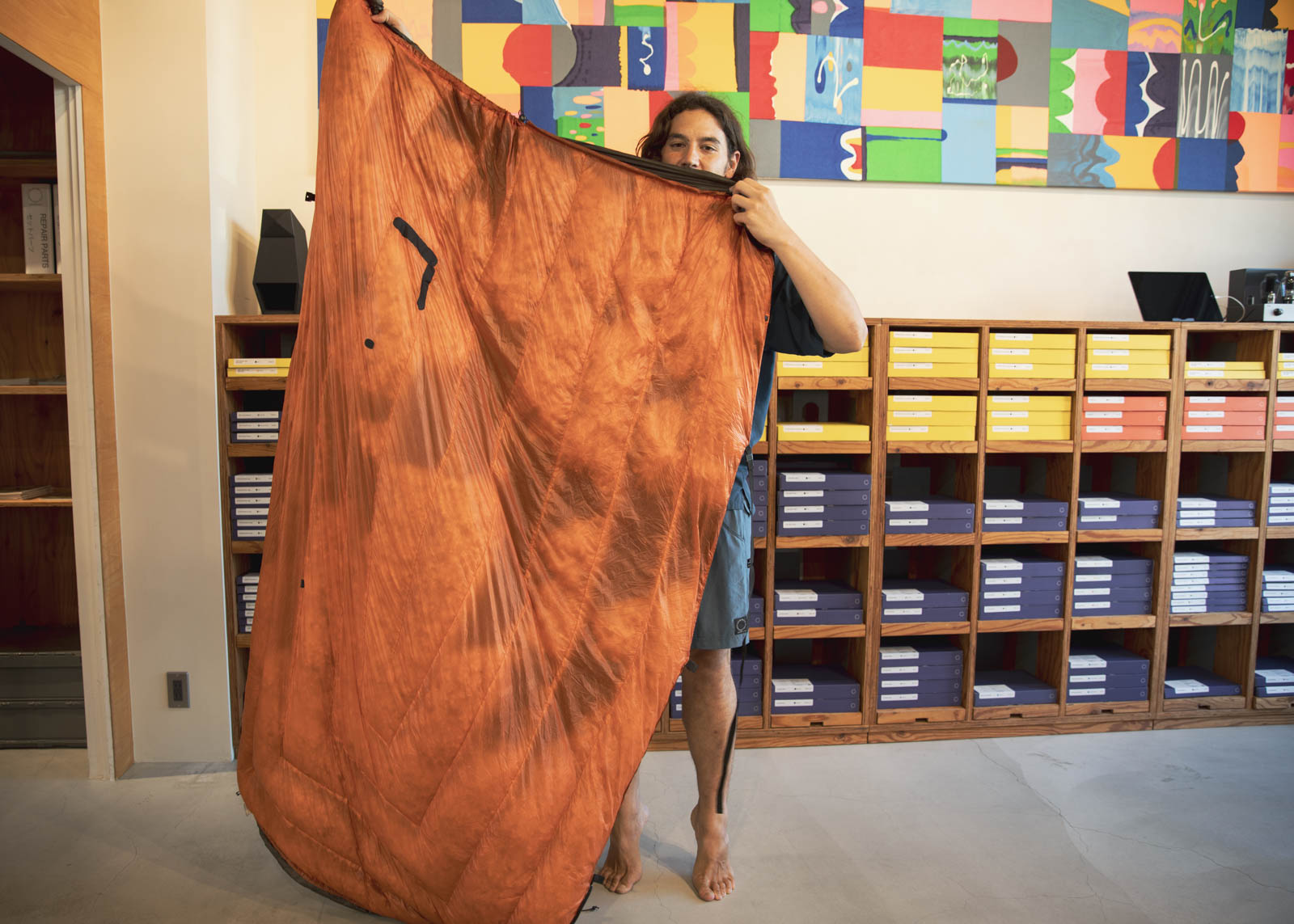
Q: Next up is your sleeping bag?
SM: Right. This is a Enlightened Equipment Revelation Custom Sleeping Quilt. It has 950 fill power down and is rated for 30 degrees F, which is about minus 1 degrees C.
Q: Your colleague, Ayumi Uesugi, also recommended an Enlightened Equipment sleeping bag. Yours looks much more worn out than hers. Did you customize this?
SM: Yes. I chose the fabric and color. The best thing about Enlightened is its reasonable price, despite the high quality. There are sleeping bags out there that weigh less, but they can be quite expensive. This one offers the best cost-performance value. For most people, sleeping in a minus 1 degree C would feel too cold. The coldest it got on the PCT was around minus 5 degrees C, and it was freezing.
Q: Was that at a high altitude? Up north?
SM: Surprisingly, it was early on, in the Sierras. I started hiking on April 20. On the third day, it snowed in the desert, and temperatures were around minus 1 degrees C. There was a day in the Sierras when it was minus 5 degrees C, and I slept in a valley where the cold air had settled. It was so cold that I had to get out of my tent. I gathered all the down around my upper body and curled up in a fetal position, like a baby in a womb. That made it quite warm. I realized that I could manage even with less down by just making adjustments like that.
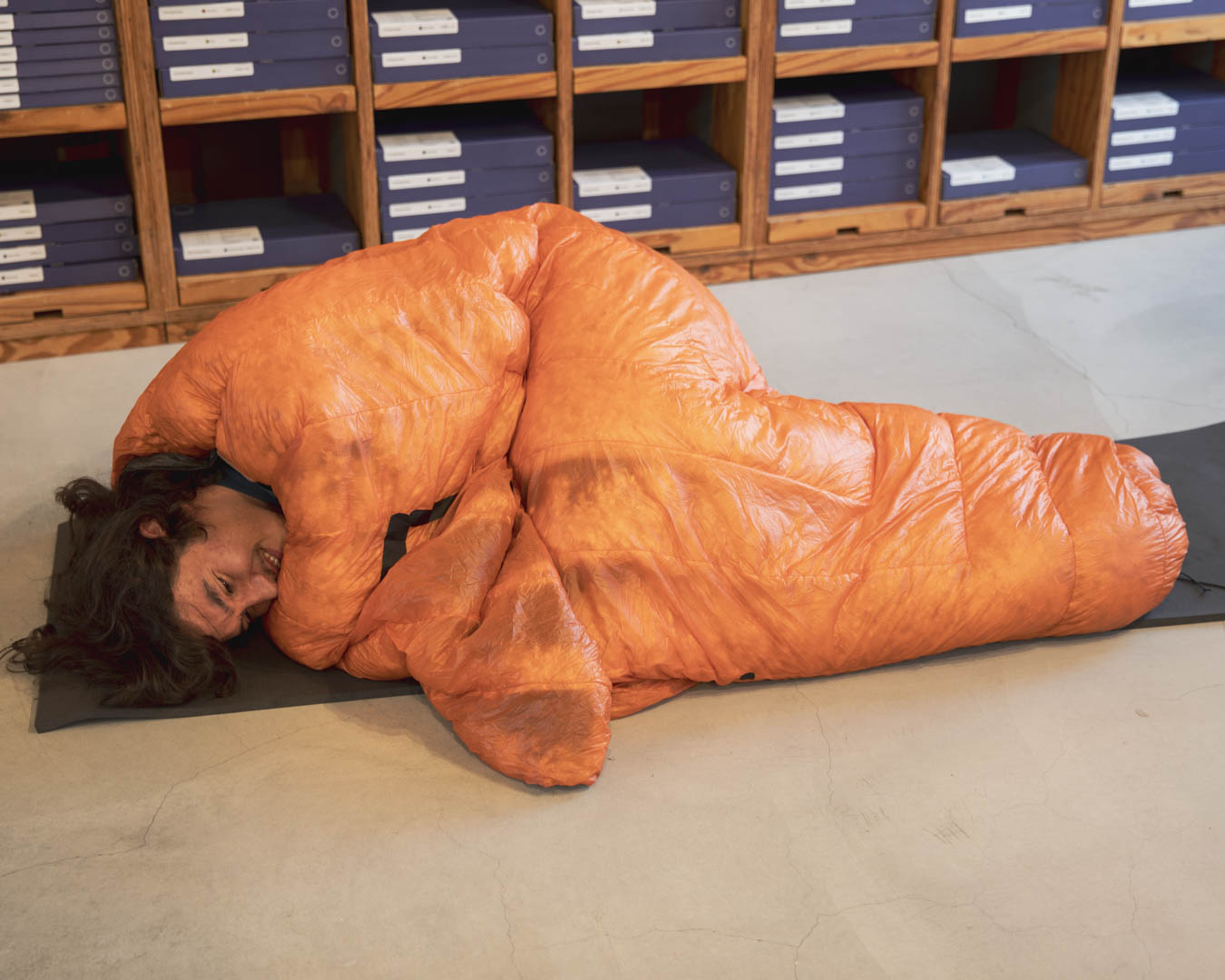
Q: This one can open up and be used in various ways, right? Did that versatility help?
SM: Yes, definitely. When you’re walking for half a year, you experience a wide range of temperatures, so that versatility was really useful. If it wasn’t too cold, I could use it like a blanket.
Q: There’s a hole in it, but there’s a story behind that, right?
SM: I have a lot of memories with this sleeping bag. It has a big L-shaped patch. This happened in a town called Tahoe, on the PCT. There’s a campground there that lets PCT hikers stay for free. I woke up to find a bear on top of me, chewing on my sleeping bag.
Q: Wow! Did you have food in your tent?
All of my food was stored in a bear box (a bear-proof container). For a week before reaching that town, I’d heard people say, “It’s dangerous there.” “Bears come out there.” But I hadn’t seen any bears at all in the Sierras. Tahoe is at the end of the Sierras. By then, I was grumbling about how I hadn’t seen a single bear in the Sierras and what a scam all the talk of bears had been. But then I encountered one! I had gotten pretty drunk and had fallen asleep. Around 5:00 in the morning, I was poked awake. When I opened my eyes, there was this ugly, big bear on top of me.
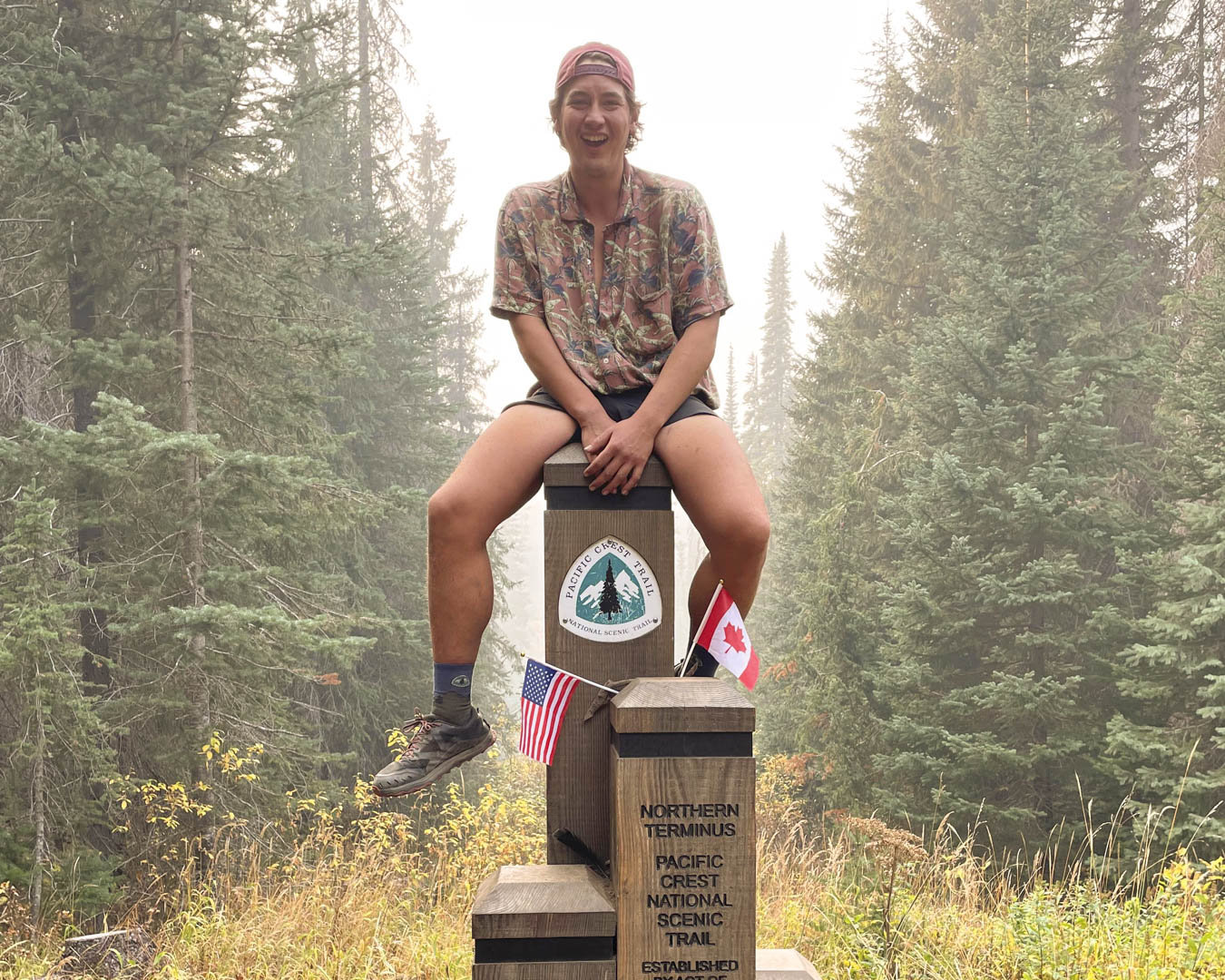
Q: That’s really scary! You were in your tent, right?
I was cowboy camping (camping without a tent). I was drunk and didn’t feel like setting up the tent, so I slept away from everyone else.
Q: Maybe you smelled tasty to the bear.
SM: Who knows? Maybe some chocolate I ate got on my shirt. When I woke up, my sleeping bag was covered in bear drool.
Q: It was licking you?
SM: It was actually biting! I ended up screeching.
Q: Were there other people around?
SM: There were a lot of people, but I was the only one cowboy camping. Everyone else was inside a tent.
Q: I see. Lesson learned!
SM: The biggest takeaway was, you shouldn’t sleep away from the group. If I had slept with everyone else, things might have been different. The next day, I saw the same bear, and it had a bunch of down feathers in its mouth.
Q: Do bears like down? Maybe it learned the taste from eating chickens or something.
SM: Maybe. When the bear attacked, down feathers went everywhere. The bear was still in front of me, but I was desperately picking up the scattered down, stuffing feathers back into the sleeping bag and patching up the hole. That’s how this ended up with a big L-shaped patch.
PHOTO of L-shaped patch
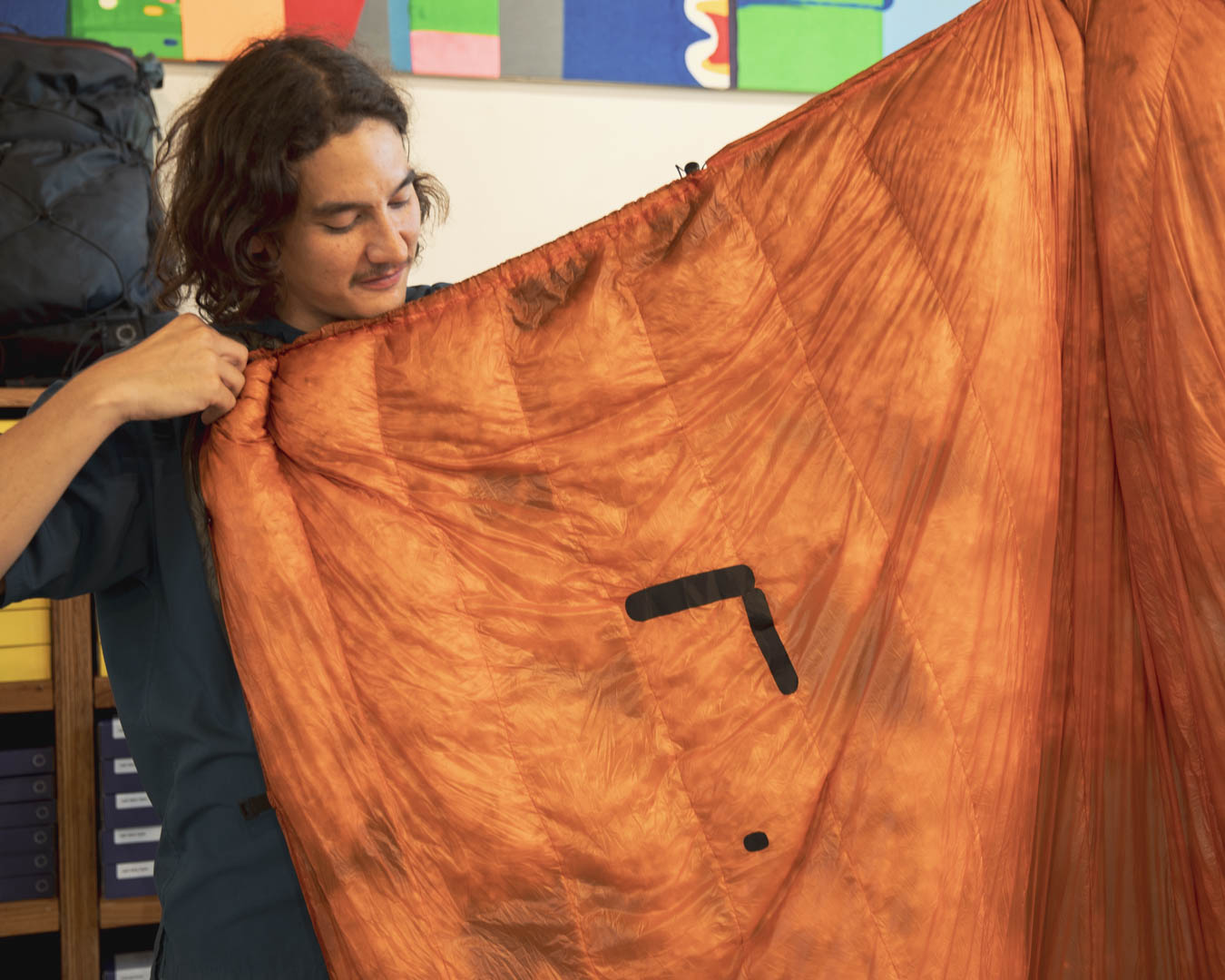
Q: That much came out?
SM: Quite a bit. I thought it would be terrible if my sleeping bag got ruined, so I desperately collected the feathers. While I was doing that, a friend came over and said: “There’s a bear right in front of you! That’s insane! Was that you who screamed? I thought that was a girl!” I still can’t believe I made that sound.
Q: When you’re desperate, it just comes out. I recently encountered a brown bear in Shiretoko, Hokkaido, and was surprised at the sound that came out of my mouth.
SM: My scream was like a 10-year-old girl’s “Kyaa!” That bear kiss made me famous on the trail. I became the Bear Smoocher.
Q: That could become your trail name: Bottom Bear.
SM: I kept hearing that story all the way to the end of the trail, even from hikers I didn’t know.
Q: When something like that happens, people on the trail talk about it. They’ll say, you have to be
careful at that campsite because of what happened last year.
SM: I’m sure this year’s PCT hikers have heard about it. They’re probably saying: “Last year, some guy got licked by a bear here.”
Q: Everyone will be saying, “Don’t cowboy camp here. Set up a tent!”
SM: This sleeping bag holds a lot of memories.
Q: Anyway, I’m glad you safely completed the trail and that you came away with a funny story.
⑤ Borah Gear - Cuben Bug Bivy
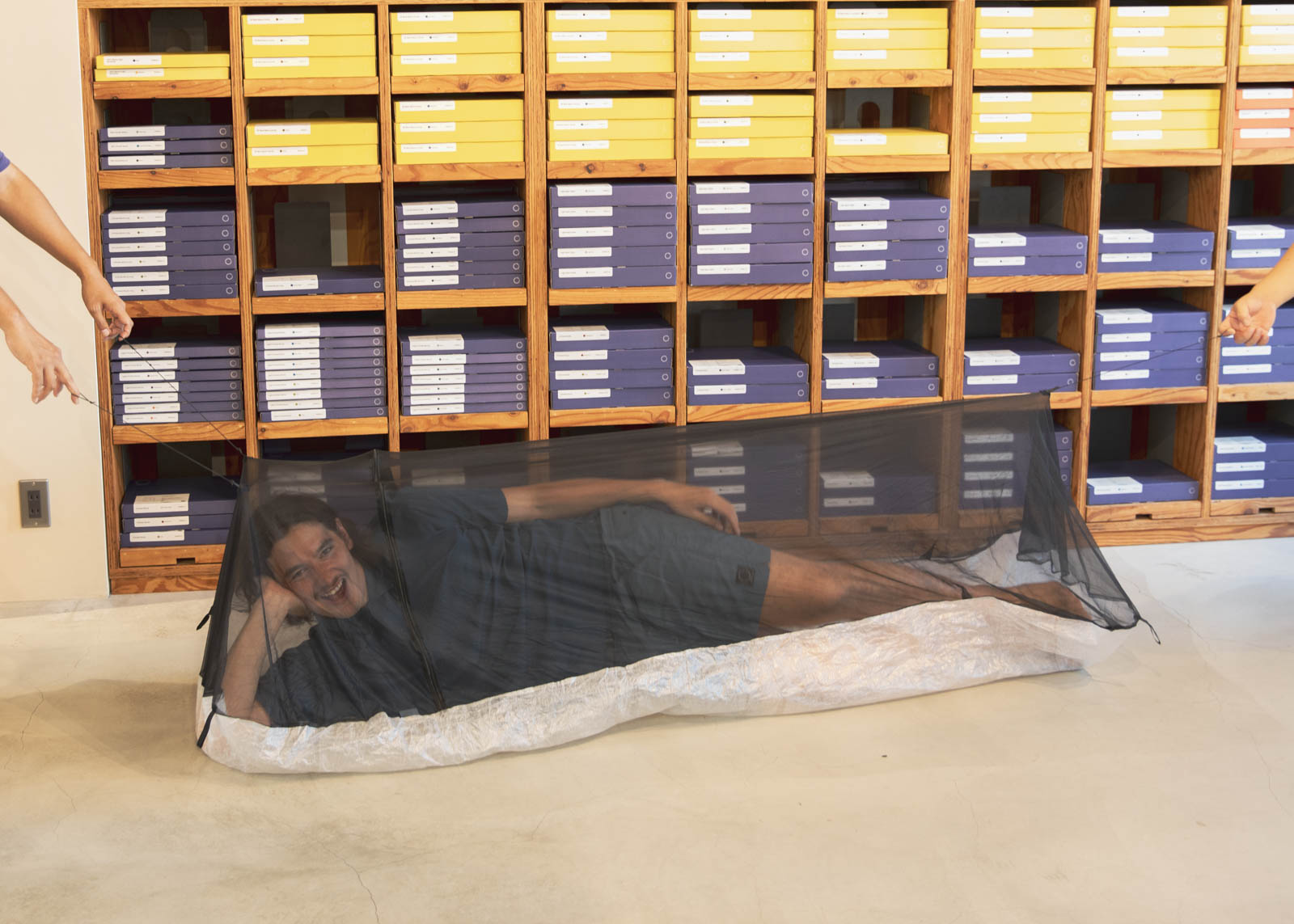
Q: And now, let’s move on to your bivouac.
SM: This last item is something I bought after I walked PCT, but I wish I had brought it with me. It’s the Borah Gear Cuben Bug Bivy, made by a garage brand in Montana.
Q: Looking at their site, I see that they seem to only make bivvies and tarps. A US brand, for sure.
SM: Mine is entirely mesh, but you can choose between nylon and a lightweight, durable laminate fabric (known formerly as cuben fiber but now commonly called Dyneema Composite Fabric) for the bottom material, and you can customize the zippers. I slept under a tarp in the Sierra, but the mosquitoes were unbearable.
Q: That’s how bad they were in the Sierras.
SM: Out of control. There were areas where about 30 mosquitoes swarmed my arms, and I was having to constantly swat them away.
Q: That’s awful. Did they come out at night, too?
SM: They’re horrific at night. Traumatically so. Because of that, I would sleep in places where the wind was blowing hard enough to keep the mosquitoes away. Every night, I’d put on my rain jacket hood and cover my face and hands with small towels to sleep. It was so frustrating that I ended up buying this bivvy.
Q: In Japan’s mountains, mosquitos aren’t much of a problem.
SM: Last week, I went hiking in the Northern Alps. The campsite was full, so I decided to cowboy camp. When I lay down, spiders and other bugs were crawling all over me. That’s when I really appreciated having the bug bivvy.
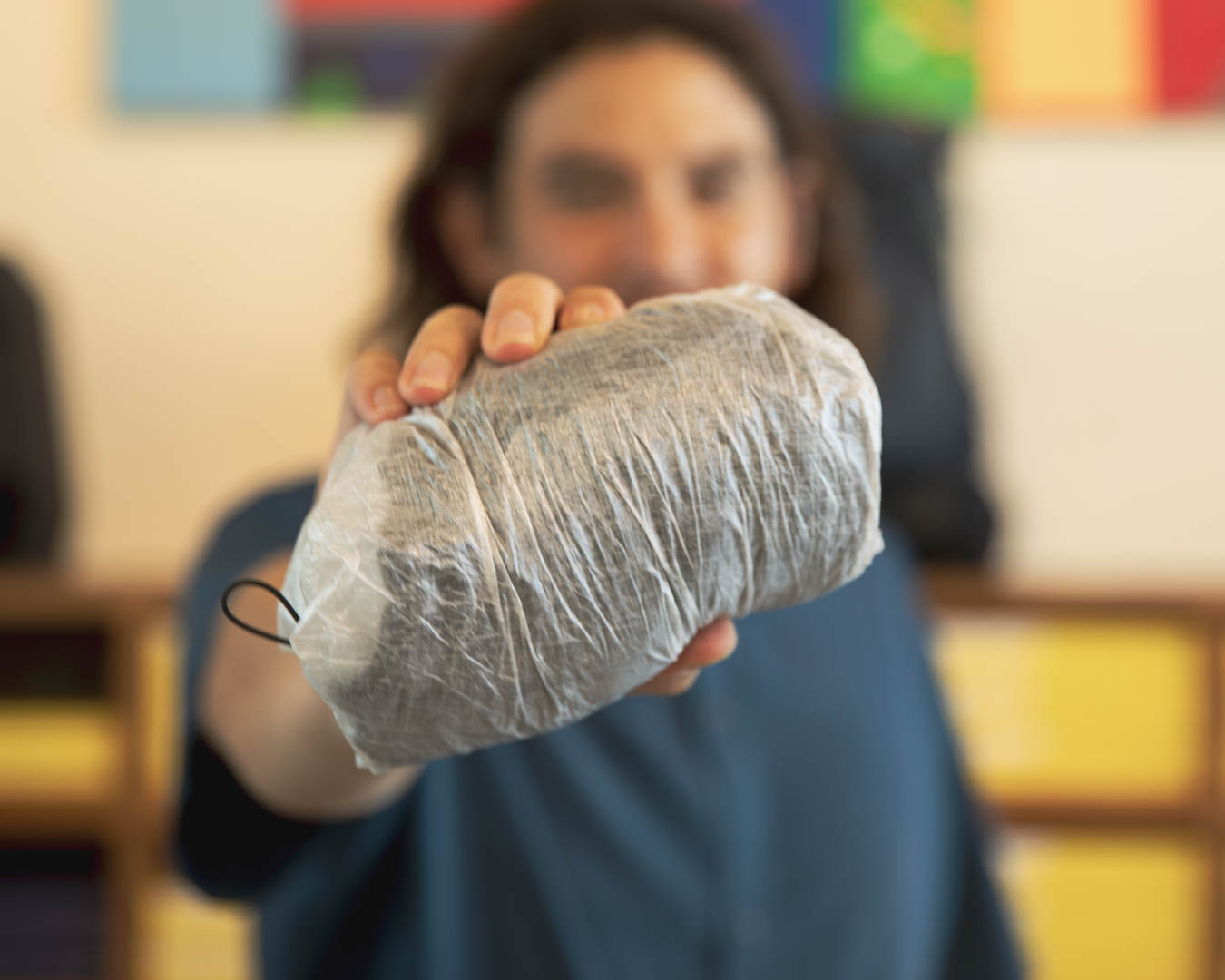
Q: Where was that?
SM: A campsite on Mt. Jōnen. It was a long holiday weekend. Some people were turning back because there was no space. I was told that it was full, but I paid the fee and squeezed my bug bivvy between tents. I didn’t get inside until after dark, and I vaguely recall in the middle of the night people being startled by my being there.
Q: Seeing a big foreigner cowboy camping at a campsite crowded with tents would be a surprise.
SM: But you can sleep anywhere, even when there’s little space. I highly recommend it. I’m lazy, and I love being able to settle down and go to sleep right away. When it rains, instead of pitching a tarp, I like to cover the bivvy directly, like a blanket.
Q: As long as it doesn’t blow away, that works.
SM: Exactly. You can set up your bedding, ghetto-style, in no time.
Q: Your recommendations and fun stories were just what I’d expect from someone who completed the PCT.
Thanks for sharing!
【CONTINUED IN PART 2】







